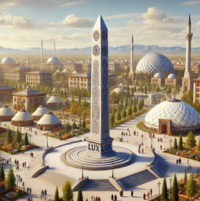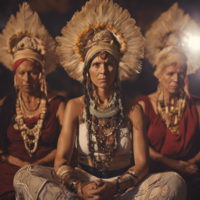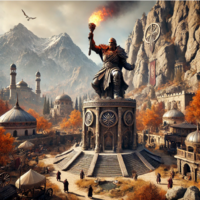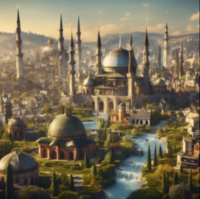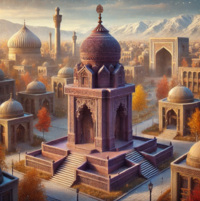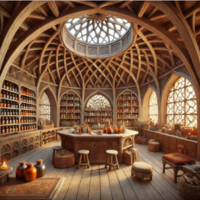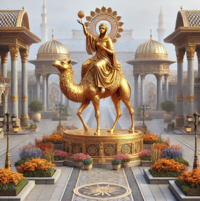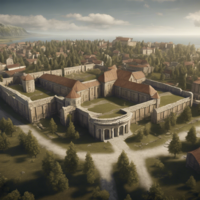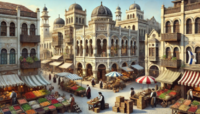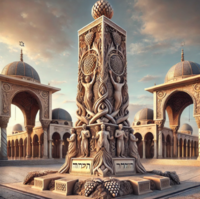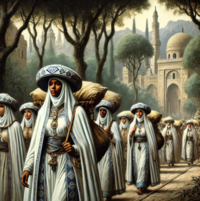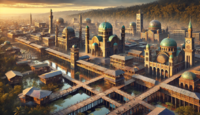List of cities in Bassaridia Vaeringheim
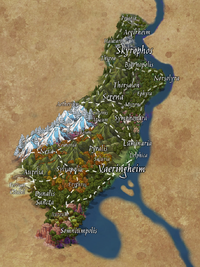
The following is a list of cities in Bassaridia Vaeringheim, including all major and minor cities.
Major Cities in Bassaridia Vaeringheim
Vaeringheim
Vaeringheim is the oldest major city in the region surrounding Lake Morovia, with a rich history dating back to the 24th era PSSC. Located on the northern shore of Lake Morovia, the city serves as the region's most important cultural, economic, and political hub, influenced by the Bassarid civilization since the 35th era PSSC. Home to the General Port of Lake Morovia and the national government of Bassaridia, Vaeringheim is home to a diverse population, architectural diversity, and a thriving, vibrant economy.
History

Vaeringheim was first established by the Kingdom of Normark in 24.22 PSSC, during the first golden age of civilization in Keltia. Since the 35th era PSSC, the city has been under the influence of Bassaridian civilization, which has long shaped its cultural, architectural, and political landscape. Over the eras, Vaeringheim has witnessed a number of important regional wars, including the Strait of Haifa Campaign, the Haifan Civil War, and the Morovian Frontier Campaign. It has furthermore undergone several significant political changes, shifting hands from Normark, to the Bassarid pirate empire of the Maritime Markets of the Strait of Haifa, to the Haifo-Pallisican Imperial Trade Union, before finally becoming the capital of Bassaridia Vaeringheim. The city, furthermore, has undergone economic transformations, having served for much of its history as the home of the Morovian-controlled Independent Port of Lake Morovia, which was later adapted to become the General Port of Lake Morovia. Throughout all of these changes, Vaeringheim has remained a resilient and highly adaptive, important urban center.
Geography
Located on the shores of Lake Morovia, on the Plains of Vaeringheim which extend from the northern edge of the Abeisan Inlent, Vaeringheim occupies a strategic position as a gateway to trade routes connecting inland cities with coastal settlements around Lake Morovia and the Strait of Haifa. The city's landscape features a mix of ancient Normarkian structures and fortifications, and a blend of modern and historical architecture which reflects the influence of the Bassarids as well as that of the nation's indigenous Alperkin population.
Economy
Vaeringheim thrives as a center of commerce, finance, and industry, with the General Port of Lake Morovia serving as a vital hub for trade and commerce throughout the region. The city's economy is driven by bustling marketplaces, financial districts, manufacturing facilities, and technological innovation hubs. The city is furthermore well-connected by an extensive transportation network, including roads, bridges, railways, and waterways, allowing for the movement of goods and people within and beyond its borders.
Culture
As a cultural melting pot, Vaeringheim boasts a vibrant arts scene, attracting artists, musicians, and intellectuals from across the region, and from across the former Bassaridian sphere of influence. The city hosts numerous cultural festivals and celebrations throughout the year, most of which reflect the influence of the Stripping Path and the Reformed Stripping Path, which highlight its diverse traditions, arts, and cuisines. Religious institutions representing various Hostian faiths, including the Bassaridian and Alperkin religions, coexist within the city, contributing to its rich cultural tapestry. Vaeringheim, with this said, is home to the Azure Sentinal Sect, the most important of the Reformed Bassarid cults, which is devoted to Thalassa, the Empress of the Planetary Divines. The city is also home to Ordo Solis Invicti, a more recent Bassarid cult which centers around the worship of Atos, the planetary divine most closely associated with the Host Spirit, and regarded as the the god of creation.
Important Citizens
While Vaeringheim has historically served as the home of the nation's most important political, military, and economic leaders, the individual with the most cultural influence is the mystic shaman, Calypso, the daughter of Thalassa and an unknown mortal. A hermit priestess of the Azure Sentinel Sect, Calypso was known for her deep connection to the sea and mystery, Calypso embodies the spirit of Vaeringheim, a city known for its maritime prowess and deep, mystical waters. Vaeringheim was also notably the home of the demi-god Triton, the son of Thalassa and an unknown mortal, who helped to ensure the safety and prosperity of Vaeringheim's maritime activities.
Luminaria
Luminaria is a unique city situated in the eastern reaches of the Plains of Vaeringheim. Originally established as an outpost by Alperkin nomads, the city has evolved as a result of settlement by Bassaridian migrants, into a cultural and spiritual center. Today the city is home to the Order of Aurora Mystica, a Reformed Bassarid cult devoted to Eos, Lady Divine of dawn. It is also home to Conclave Illuminara, another Reformed Bassarid cult which is devoted to Tarsica, Lady Divine of illumination and wisdom.
History

Founded as an outpost by Alperkin nomads, Luminaria's history is intertwined with the migration patterns and cultural practices of its founders. Over time, the city transitioned as a result of Bassarid influence, into a permanent settlement, influenced by the spiritual beliefs of its inhabitants. The establishment of the Order of Aurora Mystica in the 48th Era PSSC, further solidified Luminaria's reputation as a center for spiritual enlightenment and divine worship.
Geography
Located in the eastern reaches of the Plains of Vaeringheim, Luminaria occupies a landscape which lends itself to meditation, introspection, and communion with nature - picturesque, sparsely wooded coastal plains and rolling hills. The city itself is characterized by a blend of temporary and permanent Alperkin yurts which reflect its nomadic origins and cultural heritage, and Bassarid-inspired pueblos. The city is also, famously, built atop a network of complex underground tunnels constructed throughout natural cave systems. These tunnels played an important role in the battle for control of the city during the Morovian Frontier Campaign.
Economy
Luminaria's economy is primarily driven by agrarian practices and artisanal crafts, with the city's inhabitants cultivating the land and crafting goods reflective of their cultural traditions. Luminaria is home to several major agricultural companies featured on the General Port of Lake Morovia, including the Gladeseed Farmers Union, and the Atterian Cattle Drivers Company. The city is also the proud home of the Onceanic Boot Company, which specializes in the production of high quality boots made from the hide of the Oceanic Armored Rhino, a species of rhino which is common in the surrounding coastal plains. Meanwhile, Conclave Illuminara fuels a thriving hospitality industry within Luminaria. Inns, taverns, and tea houses cater to the needs of travelers and scholars, providing accommodation, nourishment, and a welcoming atmosphere conducive to intellectual exchange and spiritual exploration.
Culture
As a spiritual and cultural center, Luminaria embraces the teachings of the Order of Aurora Mystica, emphasizing the pursuit of enlightenment, spiritual growth, and harmony with the natural world. Rituals, ceremonies, and festivals honoring Eos, Lady Divine of dawn, are central to the city's cultural calendar, fostering a sense of community and devotion among its inhabitants.
Despite its remote location, Luminaria attracts spiritual seekers and pilgrims drawn to its tranquil surroundings and spiritual teachings. Visitors have the opportunity to participate in rituals, meditative practices, and educational programs offered by the Order of Aurora Mystica.
Important Citizens
While many notable citizens have made their home in Luminaria, two stand out above all others: Aurora and Lux. The daughter of Eos and Phaedra, and a member of the Order of Aurora Mystica, Aurora serves to this day as an inspirational figure for those seeking new beginnings and hopeful endeavors. Aurora's presence in Luminaria symbolizes the dawn of new opportunities and the pursuit of enlightenment. Lux, the son of Icaria and Pythia, and another member of the Order of Aurora Mystica, Lux was a famous philosopher who shed light on many profound truths. Lux's teachings and philosophies continue to illuminate the minds of the people in Luminaria, guiding them towards wisdom and understanding. Luminaria was also the home of the demi-god Eosphorus, the son of Glinos and Eos, who was known as the bringer of light, The city was also the birthplace of the demi-god Aether, son of Icaria and Penthia, who was known for his ability to inspire clarity and focus.
Serena
Built atop the ruins of a Normarkian military outpost, Serena is a city located in far northeastern Bassaridia Vaeringheim, nestled in the Ismaelean Mountains of the Northern Highlands. Today, it is home to the Harmony Sanctum, a Reformed Bassarid cult devoted to Micras, Lady Divine of balance and wisdom. The city's ethos centers around the cult's core values of harmony and equilibrium.
History

Founded upon the remnants of an ancient Normarkian military outpost, Serena's history is steeped in the legacy of conflict and conquest. To this end, the city served as a critical staging post for Bassarid military operations during the Strait of Haifa Campaign and during the Haifan Civil War. It was also an important base of operations for the Morovian-led Anti-Noctic League, an organization of mercenaries who worked to root out and eliminate the region's Noctic-Rabrev trade. Over time, the city transformed into a center of spiritual enlightenment, guided by the teachings of the Harmony Sanctum. The juxtaposition of past strife and present harmony symbolizes Serena's journey of resilience and renewal.
Geography
Situated in the rugged terrain of the Ismaelean Mountains of Bassaridia Vaeringheim's Northern Highlands, Serena's landscape is characterized by rolling hills, dense semi-autumnal forests, and winding rivers. The city's strategic location in the highlands, on the very northern edge of the Bassaridian frontier, offers both natural beauty and defensive advantages, shaping its development and cultural identity over the centuries.
Economy
Serena's economy is sustained by agriculture, trade, and craftsmanship, with the city's inhabitants cultivating the land and producing goods to sell on local markets and on the General Port of Lake Morovia. The city is famously the home of the Commune of the Garganid Apostles, a Bassarid merchant cult which specializes in the sale of fertilizer made from dropping deposited by a species native to the Northern Highlands, known as the Garganram. Trade routes connecting Serena to neighboring settlements facilitate the exchange of resources and materials, supporting the local economy and fostering economic stability. Serena's infrastructure is a blend of ancient ruins and modern conveniences, with remnants of the Normarkian military outpost interspersed with contemporary dwellings, temples, and gathering spaces. Roads and paths crisscross the city, connecting its various districts and allowing for the movement of people and commerce.
Culture
As the home of the Harmony Sanctum, Serena's local culture revolves around an emphasisis on the importance of balance, wisdom, and spiritual harmony. Rituals, ceremonies, and festivals honoring Micras, Lady Divine of balance and wisdom, are central to the city's cultural heritage, fostering a sense of unity and purpose among its inhabitants. Serena attracts spiritual seekers and travelers drawn to its scenic vistas and cultural heritage. Visitors have the opportunity to explore the ruins of the Normarkian outpost upon which the city is built, participate in rituals and ceremonies at the Temple of the Harmony Sanctum, and immerse themselves in the city's vibrant cultural scene, gaining insight into its rich history and spiritual traditions.
Important Citizens
The most famous of Serena's citizens is Harmonia, the daughter of Micras and an unknown mortal. A priestess of the Harmony Sanctum, Harmonia was known for her efforts in balancing the natural and social orders, Harmonia's influence ensured that Serena remains a beacon of equilibrium and peaceful coexistence. Serena was also the home of the demi-god Gaia, daughter of Plateau, who was known for her nurturing abilities and connection to nature.
Pyralis
Originally established as a sacred Alperkin spiritual center located in the northern reaches of the Gloom Forest of Perpetual Autumn, Pyralis is a haven for seekers of enlightenment and devotees of Ignis Aeternum, a Reformed Bassarid cult devoted to Pyros, the Divine of fire, passion, and transformative creativity. Within its misty confines, Pyralis is renowned for its unusual, mystical energy, which draws travelers from far and wide.
History

Pyralis's origins was originally established by the earliest Alperkin nomads who first roamed the Northern Gloom Forest, who used the location for their dark, mystical rites and rituals. Over millennia, it has served as a a refuge from the darkness that pervades the Gloom Forest.
Geography

Situated within the towering autumn giants of the Northern Gloom Forest, Pyralis is a place of great beauty. Veiled in near-constant twilight, its landscape is a mix of mist-shrouded woods, winding pathways, and ancient Alperkin and Normarkian ruins reclaimed by nature. The ever-changing hues of the forested hills surrounding the city, paint an ideal backdrop for the rituals and sacred gatherings for which the city is widely regarded.
Economy
Pyralis' economy is driven by the trade of rare and exotic goods from distant lands which is facilitated by the presence in the city of Bassaridia Vaeringheim's largest marketplace outside of the General Port of Lake Morovia, the Highland Port of Pyralian Alperkin. The Highland Port features a wide range of companies selling goods and providing services which are available nowhere else in the region.
Culture
As the home of the Ignis Aeternum, the culture of Pyralis is characterized by a strict emphasis on ancient rites and mystical ceremonies, each one a testament to the city's unwavering devotion to the Spark of Pyros. Devotees of Ignis Aeternum gather to honor Pyros, the Divine of fire, through rituals centered around a belief in the Divine's transformative power. Art, music, theater, and poetry flourish within Pyralis, each expression a reflection of the divine influence of Pyros. Pilgrims come to Pyralis to seek enlightenment and communion with the divine spark, while merchants and adventurers are drawn by the promise of treasure and abundant riches.
Important Citizens
The most notable of historical figures who have made their home in Pyralis is Liora, the daughter of Divine Agnis and Thalia. A highly esteemed member of Ignis Aeternum, who is celebrated for her fiery spirit and exceptional artistic talents. Liora's creations, and her example as an artist bring color and vitality to Pyralis, making the city a hub of creativity and innovation. Pyralis was also famously the home of the demi-god and tyrant, Ignis, son of Agnis and Thalia, who inspired the artistic community of Pyralis, driving innovation and passion in the arts.
Symphonara
Symphonara, situated in the foothills of the Ismaelean Mountains of the Northern Highlands of Bassaridia Vaeringheim, was originally established by Morovian Nationalists opposed to the encroaching influence of Bassaridia in the region. It has evolved into a hub of philosophical exploration and spiritual enlightenment. Today, Symphonara is home to the Celestial Harmony Sect, a Reformed Bassarid cult devoted to Indigo and Momiji, Twin Lady Divines representing duality and the inevitability of change. The city is also home to a second Reformed Bassarid cult, Accord Concordia, which devotes itself to the worship of Lukedu, Divine of harmony and unity.
History
Symphonara's origins lie in the tumultuous period of Morovian nationalism, when fervent patriots sought to resist the growing influence of Bassaridia in the region. Founded as a symbol of independence and opposition to Bassaridian rule, the city's early years were marked by conflict and upheaval. However, following the collapse of the Morovian Nationalist movement following the Haifan Civil War, Symphonara emerged as a symbol of hope and reconciliation, embracing the principles of unity and harmony in the face of conflict.
Geography
Located amid the peaks and valleys of the Ismaelean Mountains, Symphonara's geography is as diverse as its inhabitants. Rolling hills, cascading waterfalls, and lush coniferous forests provide a picturesque backdrop for the city's bustling streets and tranquil gardens. Symphonara's layout is a blend of Morovian fortifications, Alperkin yurt dwellings and temples, and Bassarid pueblo-style architecture. Its streets wind amidst sturdy stone structures and imposing battlements, mixed with graceful yurts and vibrant adobe buildings. This mix or architectural styles creates an atmosphere of cultural heritage, inviting visitors to explore its labyrinthine streets and bustling marketplaces.
Economy
Symphonara's economy is sustained by trade, craftsmanship, and artistic expression. Artisans, merchants, and performers carry out their trades within the city's markets and plazas, while scholars and philosophers take to public squares, gardens known as Harmony Gardens, and temples, all managed by the followers of Accord Concordia, to engage in debates and intellectual discourse. The pursuit of knowledge and enlightenment is the lifeblood of Symphonara, driving its economy and fostering a culture of innovation and creativity.
Culture
As the home of the Celestial Harmony Sect, Symphonara embraces the teachings of Indigo and Momiji, Twin Lady Divines representing duality and the cyclical nature of existence. Rituals, ceremonies, and festivals honoring the Twin Lady Divines are central to the city's cultural fabric, celebrating the beauty of diversity and the inevitability of change. Art, music, and literature abound within Symphonara's vibrant cultural scene, all of them reflections of the city's commitment to embracing the complexities of the human experience.
Important Citizens
The most famous and influential resident of Symphonara is Pax, the son of Lukedu and Helena. A member of Accord Concordia, Pax is best known for his efforts in diplomatic negotiations and peacemaking, Pax's influence promotes unity and harmony in Symphonara, making it a beacon of peace and cooperation. Symphonara was also home to the demi-god Concordia, daughter of Lukedu and Sisera, who played a crucial role in maintaining peace and unity within Symphonara.
Aurelia
Aurelia is a city situated in the Western Highlands, which was once the de-facto capital of the Morovian Nationalist movement. The city has retained its nationalist ideology, although today the culture of Aurelia is more heavily influenced by the Guild of Golden Shadows, a cult of the Reformed Stripping Path devoted to Chrysos, the Divine of wealth, thieves, spies, prosperity, and abundance.
History

Aurelia's history is deeply rooted in the Morovian Nationalist movement. To this end, the city served as a stronghold for nationalist ideology during times of political upheaval. Founded as a bastion of resistance against the external influence of the Bassarids, the city's streets once echoed with the rallying cries of native patriots fighting to preserve Morovian culture and sovereignty. While the nationalist fervor has as waned, especially in the period since the Haifan Civil War and more recently the Morovian Frontier Campaign, Aurelia's legacy as a center of ideological resistance endures, shaping the city's identity and cultural landscape to this day.
Geography
Located in the rugged terrain of the Western Highlands, near the very western border of Bassaridia Vaeringheim, Aurelia's geography is characterized by semi-arid rolling hills dotted by sparse juniper forests. The city's strategic location on the nation's remote western border provides defensive advantages, making it an ideal stronghold for nationalist forces during times of conflict. Aurelia's landscape serves as an ideal backdrop for the secretive, often illicit activities of the Guild of Golden Shadows and its associate organizations, whose members operate within the shadows of the city's streets and alleys.
Economy
Aurelia's economy is heavily influenced by the activities of the Guild of Golden Shadows. The cult and its affiliates, which include the Ergonian Spy Agency, and the Hatch Ministry, play a significant role in shaping its financial landscape. As devotees of Chrysos, the Divine of wealth and prosperity, the guild's members engage in clandestine activities such as thievery, espionage, and illicit trade, accumulating wealth and influence through covert means. While the guild's operations typically remain hidden from public view, their impact on Aurelia's economy is undeniable, with rumors of vast fortunes hidden away in secret vaults beneath the city's streets.
Culture
Aurelia's culture is characterized by secrecy, intrigue, and violence, with the activities of the Guild of Golden Shadows casting a shadow of mystery over the city's streets. While outsiders may be wary of the guild's influence, Aurelia's residents view the guild as guardians of their prosperity and security, their secretive and illicit activities seen as necessary for the preservation of the city's independence and autonomy. Despite its secretive nature, Aurelia's rich history and unique cultural landscape make it an intriguing destination for adventure-seeking travelers seeking to uncover the mysteries hidden within its shadowed alleys and hidden passages. Travelers to the city, with this said, are advised to exercise caution.
Important Citizens
Aurelia derives its name from the mortal daughter of Cato and Drusilla, Aurelia, who retired in the city after establishing a name for herself in Catonis Atrium. Catonis Atrium was also the home of the demi-god, Arete, son of Thyrsia and Leonidas, who was known as the embodiment of virtue and excellence
Somniumpolis
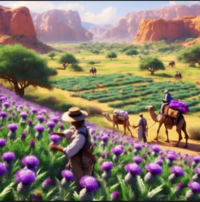
Somniumpolis is a mystical ancient city located in the Odiferae Wetlands, on the western shore of Lake Morovia in southern Bassaridia Vaeringheim. Founded by the Alperkin, its origins are shrouded in myth and legend, imbuing the city with an aura of mysticism.. Today, Somniumpolis is home to Reverie Nebulous, a cult devoted to Nephele, Lady Divine of clouds, symbolizing dreams, imagination, and inspiration.
History

The history of Somniumpolis traces back to ancient times, when the Alperkin first settled in the Odiferae Wetlands. Believed to be a place where dreams and reality intertwine, the city has long been revered as a sacred site of extreme spiritual significance, especially insofar as the city is believed to be the birthplace of Tar, the king of the High Alps which govern the Alperkin religion. Over the centuries, it has served as a center of religious practice, artistic expression philosophical inquiry, attracting dreamers, visionaries, and seekers of enlightenment from across the region. The city has in recent times, also served as a haven for the various pirate communities which operate in the swamps and open waters of Lake Morovia.
Geography
Located amidst the mist-shrouded expanse of the mystical Odiferae Wetlands, Somniumpolis's geography is as unusual as its history. The city's beauty is accentuated by the surrounding marshes, where ancient ruins and mystical landmarks dot the shadowy swamps, which are inhabited by many of the region's most unusual species such as the Low Valley Swamp Roach, Haifa's Adlet, and the Morovian Kingbird among many others, and which are lined by tall and imposing, cavernous red sandstone cliffs. The ever-changing mists that cloak the wetlands lend an air of mystery to Somniumpolis, inspiring awe and wonder in all who behold its otherworldly splendor.
Economy
The economy of Somniumpolis is driven by the production and sale of Noctic-Rabrev, a rare and highly sought-after substance with potent mystical properties. Harvested from the depths of the Odiferae Wetlands, Noctic-Rabrev is believed, in addition to inducing vampirism in those who consume its leaves in large quantity, to enhance when consumed in lesser quantities, dreaming and spiritual insight, making it a valuable commodity among practitioners of the mystic Bassaridian and Alperkin religious arts. The trade of Noctic-Rabrev sustains the city's economy, providing resources and income for its inhabitants. The city's economy, with this said, is also supported by pirates and smugglers of exotic goods, who are associated with such organizations as the Lake Morovia Blockade Fund, the Hatch Ministry, and the Baratar Corporation which claims the city as its headquarters.
Culture
Somniumpolis' culture is steeped in mysticism and artistic expression, reflecting the city's status as a haven for dreamers and visionaries. Reverie Nebulous, the cult devoted to Nephele, Lady Divine of clouds, plays a central role in shaping the city's cultural landscape, inspiring residents and visitors alike to embrace their dreams and aspirations. Visitors to Somniumpolis have the opportunity to explore its ancient ruins, participate in highly unusual rituals and ceremonies, and immerse themselves in the city's mystical ambiance, gaining insight into the mysteries of the dream realm and the boundless power of imagination.
Important Citizens
The most famous of Somniumpolis' esteemed residents is the great story-teller, Nefeli, daughter of Nephele and Leander. A high priestess of Reverie Nebulous, Nefeli was known for her imaginative storytelling and dream interpretations, Nefeli's legacy enriches the cultural and artistic tapestry of Somniumpolis, inspiring dreams and creativity among its inhabitants. Somniumpolis was also the home of the demi-god Morpheus, son of Chrysos and Nephele, who was known for his ability to influence dreams, Morpheus inspires the creativity and artistic expression within Somniumpolis.
Nexa
Nexa stands as a mystical ancient city, founded by the Alperkin deep within the heart of the Gloom Forest of Perpetual Autumn. Revered for its mysterious allure and timeless beauty, Nexa is a sanctuary of ancient wisdom and spiritual enlightenment. Today, it is home to the Eon Fellowship, a cult of the Reformed Stripping Path devoted to Glinos, Divine of ice and winter, symbolizing the eternal cycle of life and death.
History

The history of Nexa is shrouded in the mists of time, its origins lost to legend and myth. As one of the oldest settlements in the region, it has served as a bastion of knowledge and wisdom for eras. Founded by the Alperkin as a sacred site of spiritual significance, Nexa has witnessed the rise and fall of civilizations, its ancient ruins a testament to the passage of time.
Geography
Located within the depths of the Gloom Forest of Perpetual Autumn, to the north of Deerbone Cave - a vast cavern system characterized by the presence of the gargantuan bones of the ancient Titandeer which once inhabited the region - Nexa's geography is characterized by towering trees cloaked in crimson and gold foliage whichh dominate the landscape, their twisted branches reaching toward the darkened sky. Mists swirl amidst the ancient ruins and hidden glades of the Gloom Forest, veiling the city in an ethereal haze that lends an air of mystery and enchantment to its surroundings.
Economy
The economy of Nexa is sustained by the Keepers of the Bloodbaths of Laprind, a secretive order entrusted with maintaining the balance between life and death within the Gloom Forest. Revered as guardians of the natural order, the Keepers oversee sacred rituals and ceremonies carried out at the ancient Bloodbaths of Laprind, pools of highly sulfuric water mixed with wine and animal blood, and oversee the management of the temples constructed around the pools, carefully regulating access to the temple's mystical waters. Their efforts sustain the delicate ecosystem of Nexa, providing resources and sustenance for its inhabitants while safeguarding the ancient wisdom of the Alperkin.
Culture
Nexa's culture is steeped in ancient tradition and spiritual reverence, reflecting the city's status as a sanctuary of enlightenment and wisdom. The Eon Fellowship, devoted to Glinos, Divine of ice and winter, plays a central role in shaping the city's cultural landscape, inspiring residents and visitors alike to contemplate the mysteries of life and death. Visitors to Nexa have the opportunity to explore its ancient ruins, commune with the alps and the other spirits of the Gloom Forest, and participate in rituals and ceremonies carried out at the Bloodbaths of Laprind that honor the eternal cycle of existence. In a world filled with uncertainty, Nexa offers a sanctuary of peace and enlightenment for all who seek it.
Important Citizens
Nexa's most famous resident is Glacia, the ascetic daughter of Glinos and Callisto. A member of the Eon Fellowship, Glacia was revered for her endurance and ability to thrive in harsh conditions. Glacia's resilience embodies the spirit of Nexa, a city known for its strength and perseverance in the face of adversity. Nexa as also the home of the demi-god, Boreas, son of Glinos and Eos, who brought the harsh but vital winters to Nexa, shaping the city's resilience and endurance.
Lunalis Sancta
Lunalis Sancta, located in the Western Highlands, was founded as a prospective colony of the Free State of Haifa, the city has since blossomed into a haven of introspection and hidden truths. Today, it is home to the Reformed Bassarid Order of the Umbral Oracle, a cult of the Reformed Stripping Path devoted to Noctis, Lady Divine of the night.
History
Founded as a strategic outpost by ambitious colonists hoping to help support the expansion of the Haifan Free State, the city's early years were marked by colonial endeavors and cultural exchange between Haifa and the region's Alperkin and Morovian communities. Over time, however - as a result of the growing influence of the Bassarids in the region - Lunalis Sancta emerged as a center of spiritual enlightenment, drawing seekers of truth and wisdom from far and wide.
Geography
Situated amidst the rugged beauty of the Western Highlands, Lunalis Sancta's geography is characterized by rolling hills, dense forests, and a number of small, tranquil lakes. The city's strategic location near the nation's western border provides a range of benefit and advantages, and fosters economic growth and cultural exchange with the various unaffiliated tribes of central Keltia. Towering mountains loom in the distance, their peaks shrouded in mist and mystery, adding to the city's ethereal ambiance.
Economy
The economy of Lunalis Sancta is sustained by a unique blend of trade with nearby Aurelia and economic relations with native tribes beyond the nation's western border. The city's merchants specialize in rare and exotic goods, including mystical artifacts, alchemical potions, and fine, enchanted jewelry and talismans. Lunalis Sancta's reputation as a hub of spiritual enlightenment and hidden truths attracts travelers and traders from distant lands, enriching the city's economy and cultural diversity.
Culture
Lunalis Sancta's culture reflects the teachings of the Order of the Umbral Oracle. Within the city's labyrinthine streets and shadowed alleyways, seekers of truth gather to explore the depths of their own consciousness and unlock the mysteries of the universe. Visitors to Lunalis Sancta are invited to participate in rituals and ceremonies, such as the annual Nightfall Festival - a celebration of Noctis and the mysteries of the night, featuring mesmerizing performances, elaborate rituals, and exotic delicacies - that celebrate the wisdom of the night and the revelation of hidden truths. Visitors to the city may also enjoy the regionally famous Whispering Gardens, a tranquil oasis where visitors can commune with nature and contemplate the secrets of the universe amidst the gentle rustle of leaves and the whispering of the wind.
Important Citizens
Undoubtedly the most important of Lunalis Sancta's storied population is Arcana, who - as a member of the Order of the Umbral Oracle - came during her time to be known for her ability to decipher complex mysteries and secrets. To this day, Arcana continues to provide invaluable insights that help unravel the enigmatic aspects of life in Lunalis Sancta, making her a revered figure in the city. Lunalis Sancta was also home to the demi-god, Hypnos, daughter of Nikolaj and Selena, who was known for his control over sleep and dreams.
Sylvapolis
Sylvapolis, nestled in the rainy Odiferae Wetlands, is a city steeped in ancient legend and natural beauty. According to myth, it was founded eras ago by the revered High Alp Saline and marks the beginning of the path to the underworld, known in Alperkin traditions as the Emptiness. Today, Sylvapolis is home to two distinctive cults: the Mystery of the Verdant Embrace, a Reformed Stripping Path cult devoted to Opsithe, Lady Divine of harvest and nature's cycles, and the Sylvan Fellowship, a Bassarid cult devoted to Faun, Lady Divine of natural balance and fertility.
History
Sylvapolis's history is intertwined with ancient Alperkin legends of creation and the cycles of nature. Founded by the esteemed High Alp Saline, the city has long been regarded as a sacred site of spiritual significance, marking the beginning of the path to the underworld, where the realms of the living and the dead converge. Visitors to the city can today still visit the Hollow Gate, which local Alperkin tribes maintain is the beginning of the path to the Emptiness.
Geography
Located amidst the rainy Odiferae Wetlands, Sylvapolis geography is characterized by lush forests, mist-shrouded ponds and lakes where one can find the Lotos-Faces for which the region is famous, and meandering rivers which provide habitat for many of the region's most notable creatures including the Rift Valley Crocodile. Towering trees stretch towards the heavens, their branches reaching out like ancient guardians, while the near constant patter of raindrops provides a soothing backdrop to the city's tranquil, yet mysterious ambiance.
Economy
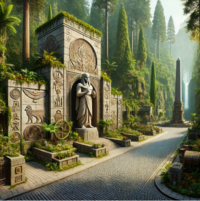
Sylvapolis' economy is rooted in the abundance of the natural world, with agriculture, fishing, and trade serving as primary sources of sustenance and income. The Mystery of the Verdant Embrace cultivates the fertile land surrounding the city, honoring Opsithe through rituals and ceremonies that celebrate the harvest and the cycles of nature. Most famous of these festivals is the annual Harvest Moon Festival, a celebration of abundance and fertility that attracts pilgrims and revelers from across the nation. During the festival, the city's streets come alive with music, dance, and feasting, as residents and visitors alike honor Opsithe and Faun with offerings of food, flowers, and prayers. Meanwhile, the Sylvan Fellowship tends to the forests and rivers, ensuring the balance and fertility of the land for future generations. Sylvapolis' marketplace is a bustling hub of activity, where merchants from distant lands gather to trade in exotic goods such as rare herbs, enchanted talismans, and mystical artifacts imbued with the powers of nature.
Culture
Sylvapolis' culture is deeply rooted in reverence for nature and the cycles of life, reflecting the teachings of the Mystery of the Verdant Embrace and the Sylvan Fellowship. Visitors to the city are invited to explore its lush forests, tranquil lakes, and verdant meadows, where they can partake in rituals and ceremonies that honor Opsithe and Faun, Lady Divines of harvest, fertility, and natural balance. Visitors to the city may also enjoy the the city's architecture, which is characterized by verdant gardens, ivy-covered buildings, and winding pathways that meander through the city and surrounding forest.
Important Citizens
The most famous of Sylvapolis rich tapestry of important historical figures who have made their home here, is Flora. The daughter of Faun and Selene, Flora was a healer known for her deep connection to nature and medicinal plants. Flora's knowledge ensured the fertility and health of Sylvapolis, fostering a harmonious relationship between the people and their environment. Sylvapolis was also famously the home of the demi-god, Verdant, son of Faun and Silene, who played a key role in ensuring the city's ecological balance and sustainability.
Minor Cities in Bassaridia Vaeringheim
Saluria
Saluria, nestled in the eastern reaches of the Gloom Forest of Perpetual Autumn, is a city renowned for its unique rchitecture and rich cultural heritage. Originally established as a haven for practitioners of the Stripping Path in Alperkin lands once formerly hostile to the religion's influence, the city is today home to Sanctum Vitalis, a Reformed Bassarid cult devoted to Plateau, Lady Divine of health and medicine, and to the Salurian Temple of Sacred Horehound, which plays a vital role in supporting the city's economy.
History
Established in the 43rd era PSSC, Saluria was established as a haven for followers of the Stripping Path during a time of high tensions between the Haifo-Pallisican Imperial Trade Union and the native Alperkin peoples. Despite initial tensions between the Alperkin and the practitioners of the Stripping Path, the founding of the cult of Sanctum Vitalis marked a turning point in Saluria's history. Through its teachings and practices, Sanctum Vitalis fostered a spirit of co-existence and collaboration between the Alperkin and practitioners of the Stripping Path. Healing rituals and ceremonies conducted by Sanctum Vitalis often incorporated elements from both traditions. Over time, these shared experiences helped to dissolve barriers, thereby reducing tensions, an contributing to a spirit of friendship and understanding between the city's diverse residents.
Geography
Saluria is situated in the eastern reaches of the Gloom Forest of Perpetual Autumn, surrounded by mist-shrouded landscapes and dense foliage. The city's idyllic setting is characterized by towering trees, winding rivers, and tranquil lakes, providing a source of inspiration and tranquility for its residents. The city's layout is characterized by broad causeways radiating outwards from the Temple of Plateau, which stands elegantly in the very heart of the city.
Economy
The Salurian Temple of Sacred Horehound plays a crucial role in Saluria's economy. Dedicated to the cultivation and worship of Horehound, a sacred herb revered for its medicinal properties, the temple serves as a center for healing and spiritual guidance. Pilgrims and visitors from far and wide flock to the temple to seek remedies for ailments and to partake in rituals and ceremonies that promote health and well-being. The temple's offerings include herbal remedies, consultations with healers, and spiritual retreats, providing a source of income for the city and its residents.
Culture
Sanctum Vitalis, dedicated to the Lady Divine of health and medicine, and the Salurian Temple of Sacred Horehound have profoundly shaped Saluria's culture. Sanctum Vitalis teaches the cultural values of healing, unity, and spiritual enlightenment, fostering a sense of compassion and cooperation among residents. Meanwhile, the Salurian Temple of Sacred Horehound emphasizes a reverence for nature and holistic wellness, encouraging a deep connection to the natural world and the healing properties of Horehound. Together, these institutions create a cultural identity centered around wellness, unity, and the relationship between all living beings, enriching the lives of Saluria's inhabitants and fostering a sense of community and belonging.
Important Citizens
While Saluria has served as the home of many important Bassaridian citizens, the most important is Iris, the daughter of Penthia and Evander. A member of one of the Reformed Stripping Path's fringe cults, Iris was a courier of the city's queen, who was known for her speed and agility in delivering important messages. Iris ensured effective communication and coordination in Saluria, supporting its role as a center of health and medicine.
Aetherium
Aetherium, situated in the furthest reaches of the snowy Northern Highlands, was established by northern Normarkian camel herders seeking to expand their trade routes and establish connections with the Alperkin. Over time, the evolved into a sanctuary of spiritual enlightenment and cultural exchange, attracting pilgrims and merchants and seekers from lands. Today, Aetherium is home to the Temple Alabaster, a Reformed Bassarid cult devoted to Ivory, Lady Divine of purity and serenity.
History

Aetherium's history is rooted in trade between the Alperkin and northern Normarkian camel herders who ventured into the rugged Northern Highlands in hopes of finding new markets in which to sell their livestock. Their encounters with the Alperkin, known for their dark mystical traditions and profound spiritual reverence, sparked a cultural exchange that led to the founding of Aetherium. The city's establishment was characterized by a blending of Normarkian pragmatism and Alperkin spirituality, creating an atmosphere of cooperation and mutual respect. Throughout the ages, Aetherium has remained a bastion of peace, spared from much of the conflict that plagued the surrounding regions, allowing its cultural heritage to flourish relatively undisturbed.
Geography
Aetherium is situated amidst the majestic snowy landscapes of the far Northern Highlands. The region surrounding the city is characterized by towering peaks, icy rivers, and expansive forests. Its remote location, far from the bustling cities of the south, contributes to an air of tranquility and isolation, making it an ideal retreat for spiritual contemplation and introspection. The mountains around the city are well regarded the favored mating grounds of the Rift Harpy, for which the region is famous. Travelers, with this said, are advised to exercise extreme caution when entering or leaving the city.
Economy
Aetherium's economy is sustained by a combination of trade, ranching, and spiritual tourism. The city's strategic location along trade routes facilitates the exchange of goods and services with neighboring settlements. The city is furthermore the home of the Camel Herders of the Jangsong Province, a Normarkian owned and operated livestock company. However, it is spiritual tourism that serves as the primary driver of Aetherium's economy, as pilgrims and seekers from far and wide flock to the hot springs of the Temple Alabaster to seek solace and enlightenment. The influx of visitors sustains local businesses, including inns, taverns, and artisan workshops, which cater to the needs of travelers and residents alike.
Culture
Aetherium's culture is deeply influenced by its spiritual heritage and the teachings of the Temple Alabaster. The city's inhabitants are known for their reverence for Ivory, Lady Divine of purity and serenity, embodying qualities of compassion, humility, and inner peace. Rituals and ceremonies conducted at the Temple Alabaster, especially at the temple's famous hot springs, serve as opportunities for spiritual growth and communion with the divine, fostering a sense of unity and harmony among residents. Artistic expression, in the form of music, dance, and visual arts, often reflects themes of purity, tranquility, and the beauty of the natural world, enriching Aetherium's cultural landscape. Through its devotion to Ivory and commitment to spiritual enlightenment. The city's culture is also heavily influenced by its Normarkian camel herders, who sell their livestock across the region. Once a year, with this said, the city's Normarkian ranchers organize a Camel Festival, which features a range of games, parades, and events which are meant to celebrate the impact of camel ranching on the city's history and its economy.
Important Citizens
Aetherium's most famous citizen is Selene, daughter of Ivory and Damon, and the favored mortal wife of Faun. An esteemed chief priestess of Temple Alabaster, Selene was regarded for her supreme beauty, and was revered for her tranquil presence and soothing influence, Selene's calming aura and healing abilities continue to bring peace and serenity to the people of Aetherium. Aetherium was also home to the demi-god, Luna, daughter of Fenrir and Damon, who was revered for her calming presence and soothing influence.
Ferrum Citadel

Ferrum Citadel, located in the high desert of far western Bassaridia Vaeringheim, was originally established as a former stronghold of Morovian Nationalism. Originally established as a military outpost by the Anti-Noctic League, an organization determined to eradicate the region's Noctic-Rabrev trade, the city has developed over time into a bastion of strength and resilience. Today, Ferrum Citadel is home to the Reformed Bassarid cult of the Court of the Ironclad, dedicated to Fenrir, Divine of strength and tenacity.
History
Ferrum Citadel's history is defined by the struggles of Morovian Nationalism and the Anti-Noctic League's historical campaign against the Noctic-Rabrev trade. Established as a military outpost to enforce the League's agenda, the city served as a bulwark against the perceived threat posed by the Noctic trade and the subsequent influx of Bassaridian commerce. Despite facing opposition from various factions, including Bassarid authorities, Ferrum Citadel remained steadfast in its mission to uphold the principles of Morovian Nationalism. Over time, the city's resolve and determination became legendary, earning it a reputation as an indomitable fortress in the desert sands.
Geography
Ferrum Citadel is located in the high desert of far western Bassaridia Vaeringheim, in a land which once was a rich, expansive swamp similar to that which today surrounds Somniumpolis, but which was rendered into an arid wasteland by an angry High Alp after being offended by the operations of the Anti-Noctic League. Characterized today by arid landscapes, and rugged terrain, the city's strategic location atop a rocky plateau provides a commanding view of the surrounding desert, allowing its inhabitants to keep watch over the vast expanse of sand dunes and red, sandstone outcrops. These rocky outcrops are the home of a highly dangerous species of giant mosquito, known as Ferrum Mosquitos, which once swarmed the region by the millions, but which today are confined to the shady crevasses and canyons of the region's rocky highlands. These giant mosquitos subsist by feeding upon the brains of their prey - using their large needle-like proboscises to penetrate the skulls of their victims and to suck out brain tissue. Despite the harsh environment, and the dangers of the desert surrounding the city, Ferrum Citadel's imposing walls and sturdy fortifications stand as a testament to its resilience and fortitude, symbolizing the unyielding spirit of its people.
Economy
Ferrum Citadel's economy is driven primarily by trade and military endeavors. The city's location along key trade routes ensures a steady flow of goods and commodities, with merchants and traders flocking from across Bassaridia Vaeringheim and from communities across central Keltia, to its markets and bazaars to conduct business. Skilled craftsmen work their trades within the city walls, producing finely crafted weapons, armor, talismans, and other goods desired by warriors, merchants, and adventurers alike. Military endeavors, including mercenary work and defense contracts, also contribute to Ferrum Citadel's economy, providing employment opportunities for its inhabitants and bolstering its reputation as a formidable military power in the region.
Culture
The city's inhabitants are known for their fierce loyalty to the principles of Morovian Nationalism and their reverence for Fenrir, Divine of strength and tenacity. Rituals and ceremonies conducted by the Court of the Ironclad serve as opportunities for spiritual communion and martial training, instilling a sense of discipline and unity among residents. Artistic expression, in the form of martial displays, military festivals, epic poetry, and intricate metalwork, reflects the city's martial heritage and its dedication to the ideals of honor and duty. Through its devotion to Fenrir and its adherence to the principles of strength and tenacity, Ferrum Citadel continues to stand as a symbol of resilience and fortitude amidst the unforgiving desert sands of western Bassaridia Vaeringheim.
Important Citizens
The most famous of Ferrum Citadel's influential residents is the military leader Freya, daughter of Fenrir and Hilda. A leader of the Court of the Ironclad, Freya was a renowned warrior and leader, symbol of courage and resilience. Freya's martial prowess and leadership continue to inspire the citizens of Ferrum Citadel to uphold their fortress with valor. Ferrum Citadel was also the home of the demi-god Skoll, son of Fenrir and Hilda, and father of the Court of Ironclad, who ensured the city's defense and military prowess
Acheron
Acheron, located in the Canyonlands of the Northern Gloom Forest, Originally served as one of the seasonal encampments for the nomadic capital city of the Alperkin, the Alpazkigz. In the period since, Acheron has as a result of the expansion of Bassarid influence, evolved into a vibrant hub of culture and commerce. Today, the city is renowned as the home of the Mystery of the Stygian Veil, a Reformed Bassarid cult devoted to Styx, Lady Divine of transformation and rebirth. Acheron's economy thrives on the cultivation of Noctic-Rabrev and the production of Noctic-infused ales and spirits, catering to the tastes of the nation's Bassarid population.
History
Acheron's history is heavily defined by the traditions of the Alperkin nomads who once roamed the Gloom Forest of Perpetual Autumn. As one of the seasonal encampments for the nomadic capital city of the Alpazkigz, Acheron served as a gathering place for tribes to convene, trade, and celebrate. Over time, owing to the powerful influence of the Bassarids, the city became a permanent settlement, attracting settlers drawn to its mystical ambiance and proximity to the spectacular Canyonlands of Acheron. Despite its transition from nomadic encampment to permanent settlement, Acheron has retained its spiritual significance, serving as a gateway to the realm of Styx, Lady Divine of transformation and rebirth.
Geography
Acheron is located in the Canyonlands of the Northern Gloom Forest, the favored hunting grounds of the Haifan Wooly Lion. The city's proximity to the canyonlands provides it with an air of mystery and beauty, as shafts of ethereal light filter through the dense foliage, casting enchanting shadows upon the canyons' forest floor. Acheron's rugged terrain and dense vegetation provide ample opportunities for exploration and adventure, while its elevated position offers panoramic views of the surrounding landscape.
Economy

Acheron's economy is heavily reliant on the traditional cultivation of Noctic-Rabrev and the production of Noctic-infused ales and spirits. The city's fertile hillsides provide ideal conditions for growing the sacred plant, which is harvested and processed by local Alperkin farmers and distilleries. Noctic-infused ales and spirits, renowned for their intoxicating effects and mystical properties, are highly sought after by the nation's Bassarid population, driving demand and stimulating economic growth. Additionally, Acheron's proximity to the Canyonlands of Acheron attracts tourists and adventurers seeking to explore the region's most important natural wonders, further contributing to the city's economic prosperity. Acheron's bustling markets and lively taverns, famous for their Noctic-based beverages, serve as gathering places for locals and visitors alike, fostering a sense of community and camaraderie amidst the mystical ambiance of the Gloom Forest.
Culture
Acheron's culture is deeply influenced by its spiritual heritage and reverence for Styx, Lady Divine of transformation and rebirth. The city's inhabitants are known for their devotion to the Mystery of the Stygian Veil, participating in rituals and ceremonies that honor the divine essence of Styx. The city is famous for its festivals, most importantly the Festival of the Veil of Renewal. This festival, held by the Mystery of the Stygian Veil in honor of Styx, takes place in the Canyonlands of Acheron during the Alperkin Cricket-Rise Festival. Participants gather at the edge of the canyon, where torch-lit ceremonies and ancient hymns create a mystical atmosphere. The festival culminates in the unveiling of a sacred veil, symbolizing renewal and transformation, as the first light of dawn breaks over the horizon.
Important Citizens
By far the most important of Acheron's historical residents in Phoenix, a member of one of the Reformed Stripping Path's fringe cults, who was believed to be the offspring either of Nikolaj and Styx, or Styx and an unknown mortal. Phoenix, with this said, was known for her transformative abilities and resilience, Phoenix's presence in Acheron symbolizes rebirth and renewal, greatly contributing to the city's reputation as a center of transformation and introspection.
Erythros
Erythros, located in the heart of the sacred Tar-Lands of the Gloom Forest of Perpetual Autumn, was originally established by members of an Alperkin cult centered around the worship of a legendary golden Adlet, known as the Archigós, believed to be a manifestation of the Host Spirit. Since its inception, the city has evolved into a place of pilgrimage and spiritual enlightenment. Today, Erythros is home to the Mystery of Red Mirth, a Reformed Bassarid cult which is led by the immortal High Priestess Fái Tahop, and which is devoted to Silenus, Divine of merriment and celebration.
History

Erythros' history is steeped in myth and legend, tracing its origins to the ancient Alperkin cult that revered a legendary, giant golden-furred Adlet as a manifestation of the Host Spirit. The city's founding marked the culmination of centuries of spiritual devotion and reverence for the divine, as pilgrims from far and wide flocked to the sacred Tar-Lands seeking communion with the Adlet and the Host Spirit. Despite its remote location, Erythros flourished as a center of religious pilgrimage and cultural exchange, drawing followers of the Alperkin faith and other spiritual traditions alike. The city's significance as a religious sanctuary spared it from much of the conflict during the Haifan Civil War and the Morovian Frontier Campaign, preserving its sacred sites and cultural heritage for future generations.
Geography
Erythros is situated within the sacred Tar-Lands of the Gloom Forest of Perpetual Autumn, a region of extreme spiritual significance for the nation's Alperkin peoples, who have long traveled here in order to carry out their Tar Funeral rituals. The Tar-Lands themselves, with their viscous pools of dark, tar-like substance, are both a physical barrier and a spiritual gateway, symbolizing the duality of life and the eternal struggle between darkness and light. Despite the harsh terrain, Erythros' inhabitants have learned to coexist with nature, drawing strength and inspiration from the timeless beauty and spiritual power of the Gloom Forest.
Economy
Erythros's economy is sustained by a combination of religious tourism, trade, and traditional craftsmanship. Pilgrims and seekers of spiritual enlightenment flock to the city's sacred sites and temples, which are devoted to a range of gods and divine beings including Bacchus, Silenus, and the Archigós, contributing to its economic vitality through offerings and donations. Trade with neighboring settlements provides essential goods and supplies, while local artisans produce finely crafted goods inspired by the city's rich cultural heritage. The Mystery of Red Mirth, with its emphasis on merriment and celebration, also stimulates economic activity through festivals and cultural events that attract visitors from far and wide. In recent times, the city has also emerged as emerged as a modern headquarters for members of the Maritime Guild of the Cult of Maskmakers, a Bassarid commercial-cult originally established in Blore Heath, but which was partially uprooted following the collapse of the Bassarids.
Culture
Erythros' culture is characterized by its deep reverence for the divine, expressed through rituals, ceremonies, and artistic expression. The city's inhabitants are known for their devout spirituality, humility, and sense of community, fostering a welcoming atmosphere for pilgrims and travelers. The Mystery of Red Mirth leads several major festivals in the city each year, known as Bacchanal, which infuse the city with an air of festivity and joy. Music, dance, and theatrical performances are integral parts of Erythros' cultural landscape, reflecting the city's vibrant spirit and rich cultural heritage. Through its traditions and rituals, Erythros continues to inspire awe and wonder, inviting visitors to embark on a journey of spiritual discovery and enlightenment amidst the timeless beauty of the Gloom Forest of Perpetual Autumn.
Important Citizens
The most influential of all Erythros' esteemed citizens is undoubtedly Diona, the most successful of all Bassarid merchants. The daughter of Chrysos and the legendary merchant queen Iphigenia, Diona - a member of the Guild of Golden Shadows - was a highly esteemed merchant who brought immense prosperity to Erythros. Diona's business acumen transformed Erythros into a thriving economic center with rich cultural heritage. Erythros was also home of the demi-god Plutus, son of Chrysos and Nephele, who - in conjunction with Diona - ensured the continued economic growth and financial stability of Erythros. The city was, furthermore, the home of Clio, daughter of Bassaria and Pindar, who is known as the muse of history,
Catonis Atrium
Catonis Atrium, situated within the juniper forests of the northern highlands, bears testament to the ancient legacy of the satyrs who once roamed the region. Renowned for their expertise in raising herds of the now virtually extinct Vegetable lamb of Tartary, the city has evolved into a bastion of discipline and order under the auspices of Rex Catonis, a Reformed Bassarid cult devoted to Cato, Divine of discipline and order.
History
Catonis Atrium's history is deeply intertwined with the traditions of the satyrs, who lived and worked in the region's juniper forests and tended to their prized herds of vegetable lambs of Tartary. As guardians of the land, the satyrs instilled a sense of discipline and harmony within their community, guided by the principles of order and balance. Over time, the city grew into a thriving center of agriculture and commerce, drawing merchants and travelers from distant lands. With the rise of Rex Catonis, the city embraced a new era of discipline and order, honoring the teachings of Cato and upholding the values of integrity and self-discipline.
Geography
Catonis Atrium is situated amidst the lush juniper forests of the northern highlands, where towering trees and rolling hills create a picturesque backdrop for the city. The juniper forests provide ample resources and sustenance for the city's inhabitants, while the crisp mountain air invigorates the spirit and soul. The surrounding landscape, with its winding rivers and verdant forested meadows, offers countless opportunities for exploration and adventure, making Catonis Atrium a haven for nature enthusiasts and outdoor enthusiasts alike.
Economy
Catonis Atrium's economy is supported primarily by agriculture, craftsmanship, and trade. The city's fertile lands yield bountiful harvests of juniper berries, which are harvested and processed into various goods such as food, medicine, and beverages. Skilled artisans and craftsmen ply their trade within the city walls, producing finely crafted goods and wares highly sought after by locals and visitors alike. Trade with neighboring settlements and distant lands further stimulates economic activity, enriching the city's cultural tapestry with diverse goods and commodities.
Culture
Catonis Atrium's culture is defined by its reverence for discipline, order, and self-improvement. The city's inhabitants are known for their industriousness, integrity, and commitment to excellence, reflecting the teachings of Cato, Divine of discipline and order. Rituals and ceremonies conducted by Rex Catonis serve as opportunities for spiritual growth and personal development, fostering a sense of community and camaraderie among residents. Several festivals take place throughout the year, honoring the ancient satyrs and the herds of vegetable lamb which they once raised by the thousands. Through its devotion to Cato and its commitment to discipline and order, Catonis Atrium continues to thrive as a beacon of integrity and self-improvement in the juniper forests of the northern highlands.
Important Citizens
Catonis Atrium was famously the home of Aurelia, one of Bassaridia's greatest military and political leaders. The daughter of Cato and Drusilla - and purportedly the first cousin of the empress Kan Zen - Aurelia was a strict devotee of the cult of her father, and was famous for her leadership and organizational skills in governance. Catonis Atrium was also the home of the demi-god, Secutor, son of Cato and Drusilla, who was known for his discipline and strategic mind.
Delphica
Delphica, situated in the Coastal Woodlands of eastern Bassaridia Vaeringheim, holds a rich history as the northern headquarters of the Couriers of the Lizard Queen, an ancient Bassarid commercial cult consisting entirely of women, who practice a type of magic which provides protection against the region's parasitic wisps. Today, the city is home to Sanctum Delphica, a Reformed Bassarid cult devoted to Sisera, Lady Divine of reflection and introspection.
History
Delphica's history is deeply rooted in the traditions of the Couriers of the Lizard Queen, who established the city as a bastion of protection against the parasitic wisps that inhabit the northern shores of Lake Morovia and the northern Strait of Haifa. Guided by their religious practices and devotion to the Lizard Queen, the cult's members played a crucial role in safeguarding travelers and merchants from the malevolent influence of the wisps. Over time, the city grew into a thriving center of commerce and spirituality, drawing pilgrims and seekers from far and wide. With the rise of Sanctum Delphica, the city embraced a new era of spiritual introspection and enlightenment, especially following the establishment of the Temple University of Delphica, which is today the largest institute of higher education in Bassaridia Vaeringheim.
Geography
Delphica is located in the Coastal Woodlands of eastern Bassaridia Vaeringheim, where dense redwood forests and winding rivers create a tranquil setting for the city. The Coastal Woodlands, with their lush vegetation and abundant wildlife, offer sanctuary and sustenance for the city's inhabitants, while the gentle rolling of waves against the shore provides a soothing backdrop for contemplation and introspection.
Economy
Delphica's economy is supported by a combination of trade, agriculture, and spiritual tourism. The city's location along the shores of the Northern Strait of Haifa facilitates trade with neighboring settlements and distant lands, while its fertile lands yield bountiful harvests of crops and herbs prized for their medicinal properties. The city's economy is, to this day, still heavily supported by the Couriers of the Lizard Queen, whose members offer their services to merchants and travelers seeking protection from the region's parasitic wisps. The city's economy is also supported by enrollment in the Temple University of Delphica.
Culture
The culture of Delphica is profoundly shaped by the influence of the Couriers of the Lizard Queen, and that of Sanctum Delphica. The Couriers, revered for their ancient religious traditions which create protective wards against the parasitic wisps that haunt the northern shores of Lake Morovia, instill a sense of reverence for nature and spiritual guardianship among the city's inhabitants. Their presence offers a sense of security and trust, fostering a community that values mutual support and collective well-being. Concurrently, Sanctum Delphica's stewardship of the Temple University of Delphica elevates the city's cultural landscape, positioning it as a beacon of knowledge and enlightenment in Bassaridia Vaeringheim. The university, renowned as the largest institute of higher education in the region, cultivates a culture of intellectual curiosity, introspective exploration, spiritual growth, and academic excellence. Together, the Couriers of the Lizard Queen and Sanctum Delphica shape Delphica into a thriving center of spiritual enlightenment, academic achievement, and communal harmony.
Important Citizens
Delphica has historically been the home of many of the nation's great intellectual leaders and philosophers. Most notable of these is Anteros, son of Sisera and Tycho. One of the nation's greatest philosophers, Anteros' philosophy was heavily impacted by the doctrines of Sanctum Delphica, though he never claimed membership in the cult. Anteros, with that said, was known for his reflective nature and great philosophical insights. Delphica was also home to the demi-god, Libera, daughter of Lukedu and Sisera, who was known for her reflective nature and philosophical insights.
Koinonía
Koinonía, a city nestled in the juniper-covered foothills of the Northern Highlands, was originally established by Bassarid missionaries with the aim of spreading the teachings of the Stripping Path into northern Alperkin-controlled territories. Today, it serves as the home of Ordo Amicitia, a Reformed Bassarid cult devoted to Erasmus, Divine of charity. Beneath the city lies an ancient underground labyrinth, known as the Tahyrint Penbellence, rumored to be the domain of a fierce minotaur. Legend holds that this minotaur was once a man cursed and imprisoned within the labyrinth after offending the Bride of the Host Spirit.
History
Koinonía's history is steeped in the religious traditions of Bassarid missionaries of the cult of Apollo, who sought to extend the influence of the Stripping Path into the rugged terrain of the Alperkin-controlled juniper forests of the Northern Highlands. Facing resistance from the Alperkin inhabitants, the missionaries persevered, eventually establishing Koinonía as a center of Bassarid faith and community. Over time, the city flourished, attracting the religion's followers from far and wide who were drawn to the region for its strong traditional Bassarid community, and later by the teachings of charity and compassion espoused by Ordo Amicitia.
Geography
Koinonía is situated amidst the juniper-covered foothills of the Northern Highlands, its rugged terrain offering both challenges and opportunities for its inhabitants. The city's strategic location provides panoramic views of the surrounding landscape, while the dense forests and winding rivers offer sanctuary for its residents. Beneath the surface lies the mysterious underground labyrinth, home to a minotaur who was cursed to reside for eternity in the labyrinth's twisting passages which to this day remain shrouded in darkness and mystery.
Economy
Koinonía's economy is driven by a combination of agriculture, trade, and spiritual tourism. The fertile soil of the Northern Highlands yields bountiful harvests of crops and herbs, which are cultivated by the city's inhabitants and traded with neighboring settlements. The city, to this end, is home to the northern branch of the Plains of Jogi, the nation's largest producer of grain. Additionally, Koinonía's status as a center of religious devotion and pilgrimage attracts visitors from far and wide, stimulating economic activity through the sale of religious artifacts, offerings, and services. Rumors of treasure within and danger within the vast, shadowy labyrinth which lies below the city, entice adventurers from across the region to the city.
Culture
Koinonía's culture is characterized by its deep-rooted faith in the principles of charity, compassion, and community. The city's inhabitants, guided by the teachings of Ordo Amicitia and the Divine Erasmus, and by the ancient customs of the Bassarid cult of Apollo, prioritize acts of kindness and altruism in their daily lives. Rituals and ceremonies conducted by the cult serve as opportunities for spiritual growth and communal bonding, fostering a sense of unity and fellowship among residents. Most famous among these rituals is the Offering to the Bride of the Host Spirit, which sees residents making offerings of flesh and treasure to appease the Host Spirit's bride, so as to maintain the minotaur's confinement within the labyrinth. Participants gather around an altar at the labyrinth's entrance, presenting food, livestock, and precious artifacts as symbols of contrition and reconciliation with the divine. Through prayers and rituals, they seek to ensure the city's safety by honoring the ancient pact with the Bride of the Host Spirit.
Important Citizens
Throughout its history, Koinonía has served as the home of many notable individuals - perhaps more than any other city in Bassaridia Vaeringheim. Of the many influential figures who have made their home in Koinonía, three are especially notable: Galen, Sophos, and Kyra. Galen, son of Ampelos and Cleon, and a member of the Harmony Sanctum, was a Famous healer whose techniques are still studied and practiced, Galen's contributions to medicine have brought health and prosperity to the diverse populace of Koinonía. Spohos, daughter of Erasmus and Cassandra, and a devout practitioner of Ordo Amicitia, was a renowned sage whose teachings have influenced many scholars. Sophos' wisdom and guidance have shaped the intellectual and cultural development of Koinonía. Kyra, daughter of Nikolaj and Selena, and - like Sophos - a member of Ordo Amicitia, was known for her calming influence and ability to heal through rest, Kyra's presence brings peace and rejuvenation to the people of Koinonía, enhancing the city's reputation as a center of healing and wisdom. Koinonía has also served as the home of more demi-gods than any other city. Among these are Hephaestus, son Pyros and an unknown mortal, who was known for his exceptional craftsmanship and innovation. Hermes also made his home here. The son of Ampelos and Penthia, Hermes was renowned for his speed and cunning, playing a crucial role in maintaining communication and trade routes within Koinonía. The demi-god, Hypatia, also made her home in Koinonía. The daughter of Erasmus and Nyssa, Hypatia was revered for her intellectual brilliance.
Aureum
Aureum stands as a testament to the ancient Alperkin Gold-eaters, a race renowned for their consumption of the precious, glistening metal mined to this day from the surrounding hills. Today, the city thrives as the seat of Temple Illuminata, a Reformed Bassarid cult devoted to Nikolaj, Divine of Epiphanies. Ruled directly by the High Alp Lulanu, believed by local Alperkin tribes to be the daughter of the Host Spirit, Aureum pulsates with a rich blend of history, spirituality, and opulence.
History
Founded by the gold-eaters of ancient lore, Aureum's roots delve deep into the annals of Alperkin history. The city's origins trace back to the discovery of abundant gold deposits in the nearby hills, which fueled the prosperity and influence of its ancient founders. Over the centuries, Aureum has evolved from a mining settlement into a thriving metropolis, its fortunes intertwined with the ebb and flow of gold and spiritual enlightenment. Despite its growth, traces of Aureum's earliest founders can still be seen on virtually every street and corner, and the influence of the gold-eaters weighs heavily upon the city.
Geography
Nestled amidst the undulating, rolling hills that have long been synonymous with gold, Aureum boasts a picturesque setting that captivates the senses. The city is surrounded by lush forests and meandering rivers, providing a tranquil backdrop to its bustling streets and opulent, traditional Alperkin architecture. Located in a region steeped in natural beauty and spiritual significance, Aureum draws visitors from far and wide seeking both material wealth and enlightenment.
Economy
Aureum's economy is anchored in the legacy of its gold-rich surroundings, with mining and trade serving as pillars of prosperity. The city's artisans, who are collectively represented on the General Port of Lake Morovia by the Shï Collective, are renowned for their craftsmanship in transforming the precious metal into exquisite jewelry, sculptures, and artifacts that fetch premium prices in markets near and far. Additionally, Aureum's status as a spiritual hub attracts pilgrims and seekers, contributing to the city's vibrant economy through offerings, donations, and spiritual tourism
Culture
Aureum's culture is a tapestry woven from threads of tradition, spirituality, and artistic expression. Temple Illuminata stands as a beacon of enlightenment, where devotees gather hoping to receive profound revelations under the guidance of Nikolaj, Divine of Epiphanies. The city's streets pulse with the rhythms of life, as festivals celebrating Alperkin heritage and spiritual teachings infuse the air with music, dance, and celebration. At its heart, Aureum exudes a sense of wonder and reverence, where the pursuit of both material wealth and spiritual enlightenment converge in harmony..
Important Citizens
The most notable of all historical figures to have made their home in Aureum is Sol, King of the Gold Eaters, and son of Chrysos and either an unknown mortal, or Opsithe. Regarded by some as a demi-god rather than a mere mortal, Sol was a great philosopher best known for bringing enlightenment and clarity to the people of Aureum. Sol’s presence in Aureum symbolizes the pursuit of wisdom and the illumination of truth, greatly contributing to the city's reputation as a center of knowledge and cosmic insight. Aureum was also home to the demi-god, Calliope, daughter of Ariadna and Orpheus, who was regarded as the muse of epic poetry and eloquence.
Major Cities in New South Jangsong
Skýrophos

Skýrophos is a prominent city in the Normarkian region of New South Jangsong, renowned for its rich blend of Haifan and Normarkian heritage. Situated along the western shores of the Northern Strait of Haifa, the city is a vibrant hub of commerce, culture, and craftsmanship. Known for its strategic location, enchanting natural surroundings, and resilient spirit, Skýrophos has maintained its unique identity and autonomy despite historical challenges and external pressures.
History
Skýrophos was founded by Normarkian settlers seeking new trade opportunities and fertile land. Over the centuries, it evolved into a bustling center of commerce and culture, blending Haifan architectural elegance with Normarkian fortitude. The city has a storied history of resistance against external control, particularly during the early 49th era when Bassaridia Vaeringheim attempted to assert dominance. The assassinations of influential local leaders by the Hatch Ministry led to internal strife and the eventual establishment of Bassarid-friendly governance. Despite these challenges, Skýrophos has always maintained a strong sense of identity and resilience.
Geography
Skýrophos is uniquely situated between the shimmering Suncliffs and the mystical Alterbulb Forest. The Suncliffs - several hundred feet tall with huge sparkling quartz formations, provide a natural defense and beauty, rising majestically around the city. The Alterbulb Forest, filled with ancient, luminescent trees, surrounds the outskirts of Skýrophos, offers abundant natural resources. The city’s well-protected harbor, framed by natural rock formations, serves as an ideal strategic port for maritime activities. These geographical features contribute to Skýrophos' enchanting and strategic importance.
Economy

The economy of Skýrophos is diverse and unique, blending traditional maritime trade with specialized local industries. The city's port is a crucial hub for commercial exchanges with neighboring regions and distant lands. Skýrophos is particularly renowned for its unique craftsmanship, producing goods believed to be imbued with magical properties from Alterbulb's luminescent wood and Suncliff's quartz. Local artisans create everything from enchanted jewelry and tools to extremely intricate glowing mosaics which are commonly purchased and displayed in major landmarks across the region. Additionally, the city's thriving fishery, known for the production of large quantities of Atterian Armored Pufferfish - a prized delicacy - plays a significant role in the local economy.
Culture
Skýrophos is a melting pot of cultural influences, with its architecture featuring a harmonious blend of classical Haifan-inspired temples and Normarkian longhouses. Cultural life in the city revolves around numerous festivals and traditions celebrating its maritime heritage and historical roots. One of the most celebrated events is the Festival of the Luminous Night, held annually under the glow of the full moon. During this festival, the city is adorned with luminescent decorations from Alterbulb wood. The festivities include a grand parade featuring mythical creatures, music, dance, and feasts with local delicacies like armored pufferfish and specialized local pastries. The highlight is the ceremonial lighting of the King Alterbulb Tree in the central square, illuminating the night and symbolizing unity and pride in Skýrophos' unique heritage.
Bjornopolis
Bjornopolis is a thriving city, known for its rich Normarkian heritage and bustling trade activities. The city serves as a key trading hub and cultural center. Renowned for its strategic location, natural beauty, and resilient spirit, Bjornopolis has successfully blended its historical roots with modern advancements.
History
Bjornopolis was established by Normarkian settlers who recognized the strategic and economic potential of its location. Over time, it developed into a significant trading center, attracting merchants from across the region. The city's merchant guilds have historically played a vital role in its economic and political life. During the early 49th Era PSSC, Bjornopolis became a focal point of the Hatch Ministry's covert operations, as Bassarid agents sought to infiltrate and disrupt local trade networks. Despite significant resistance from the local merchant elite, Bassarid influence gradually increased, altering the city's power dynamics.
Geography
Bjornopolis is uniquely located on the edge of the Agnian Fjord. The city is built upon a series of terraces that rise from the fjord, offering stunning views of the surrounding area. The Sirenian Falls, a series of cascading waterfalls that produce melodic sounds as the water flows over the cliffs, are a prominent feature of the city's geography. Dense, forests surround the city, inhabited by many of the creatures for which the Strait of Haifa is famous, such as the Garganram and the Bijarian Ring-Tailed Leopard. The city's natural harbor is protected by towering granite cliffs, making it a safe and strategic port for maritime activities.
Economy
The economy of Bjornopolis is diverse and innovative, blending traditional maritime trade with unique local industries. The city's port facilitates extensive commercial exchanges, making it a crucial hub in the trade networks of New South Jangsong. Bjornopolis is renowned for its unique floating markets, where traders sell goods from brightly colored boats, creating a vibrant and dynamic trading environment. In addition to trade, the city is known for its production of textiles woven from the silk of the mythical sphinx moth, which can be found in abundance the forests surrounding the city. These textiles, imbued with restorative medicinal properties, are highly sought after across the region. The city also has a thriving brewing industry, producing a variety of meads and ales flavored with rare herbs and spices from the surrounding forests.
Culture
Bjornopolis is a cultural melting pot, reflecting its Normarkian roots and the diverse influences brought by centuries of trade. The city's architecture features sturdy wooden structures adorned with intricate carvings and runes, blending traditional Norse designs with elements of fantasy. Cultural life in Bjornopolis revolves around its bustling marketplaces, lively festivals, and strong community ties. One of the most celebrated events is the Festival of the Sirenian Falls, held annually during the spring equinox. During this festival, the entire city is adorned with lanterns made from luminescent flowers harvested from the Alterbulb Forest, and the falls are illuminated with enchanted lights, creating a magical atmosphere. The festival begins with a grand procession through the city, featuring performers dressed as mythical creatures from local legends. The highlight of the festival is the Water Dance, a mesmerizing performance where dancers mimic the flow of the falls, accompanied by the melodic sounds of the cascading water. The festival also includes music, storytelling, and feasts featuring local delicacies, such as enchanted pastries and mead. The Festival of the Whispering Falls is a celebration of Bjornopolis' unique heritage, blending magic, culture, and community in a dazzling display of unity and pride.
Aegirheim

Aegirheim is a fortified city renowned for its shipbuilding prowess and maritime traditions. Nestled along the rugged coastline of the Northern Strait of Haifa, the city is a formidable naval stronghold and a vibrant cultural hub. Known for its strategic location, resilient spirit, and unique, natural beauty, Aegirheim stands as a testament to the enduring legacy of its Viking and Greek founders.
History
Aegirheim was founded by Normarkian clans who sought to create a fortified settlement with robust shipbuilding capabilities. Over time, it grew into a major naval power, renowned for its shipyards and maritime expertise. The city's strategic importance made it a prime target during the Bassarid expansion efforts in the early 49th Era PSSC. The Hatch Ministry's sabotage operations caused significant delays in the construction and maintenance of Aegirheim's fleet, weakening its naval capabilities. Despite these challenges, Aegirheim's resilient workforce and strategic initiatives allowed it to recover and maintain its status as a key maritime center.
Geography
Aegirheim is uniquely situated on a dramatic stretch of coastline, where the jagged cliffs of the Pythe Spine Mountains meet the enchanted waters of the Northern Strait of Haifa. The Pythe Spine Mountains, with their snow-capped peaks and hidden caves, provide a natural defense and a source of key materials used in shipbuilding. The city's harbor is protected by the Teeth of the Leviathan, a series of rocky outcrops resembling the jaws of a massive Glinos Leviathan. The nearby Alterbulb Forest, shrouded in perpetual mist, is home to unique creatures and luminescent plants. The enchanted Aengir's Bay, known for its shimmering bioluminescent waters, lies adjacent to the harbor and serves as a vital fishing ground and source of inspiration for local artisans.
Economy
The economy of Aegirheim is distinct and multifaceted, with a strong emphasis on maritime activities and craftsmanship. The city's shipyards are renowned for producing high-quality vessels, incorporating durable materials from the Pythe Spine Mountains. Aegirheim’s blacksmiths and craftsmen create finely crafted weaponry and tools, known for their exceptional quality and durability. The city’s thriving fishery, centered around Aegir's Bay, harvests sea creatures, such as the Amina Crab and the elusive Morovian Saucer-Eyed Giant Eel, which are prized for their distinctive flavors and culinary uses. Additionally, Aegirheim has a burgeoning trade in artisanal goods, attracting merchants and adventurers from far and wide. The city's markets are vibrant and dynamic, offering everything from expertly woven textiles to finely made pottery and metalwork, contributing to its reputation as a center of high-quality craftsmanship and trade.
Culture
Aegirheim’s culture is deeply rooted in its Normarkian heritage and maritime traditions, with a strong emphasis on community, resilience, and craftsmanship. The city’s architecture features sturdy stone fortifications, timber longhouses adorned with intricate carvings, and workshops filled with specialized tools and materials. Cultural life in Aegirheim revolves around its shipyards, markets, and communal gatherings, celebrating the city’s seafaring legacy and impressive natural surroundings. One of the most celebrated events is the Festival of the Aurora Lights, held annually during the winter solstice. During this festival, the entire city is illuminated with lanterns and magical lights, transforming Aegirheim into a glowing wonderland. The festivities begin with a grand naval parade, featuring ships adorned with enchanted sails and decorations. The highlight of the festival is the Aurora Dance, a mesmerizing performance on the waters of Aengir's Bay, where dancers in luminescent costumes mimic the movements of the shimmering waves. The festival also includes music, storytelling, and feasts featuring local delicacies, such as Amina Crab stew and locally produced mead. The Festival of the Aurora Lights is a celebration of Aegirheim’s unique heritage, blending culture and community in a dazzling display of unity and pride.
Norsolyra
Norsolyra is a captivating city known for its unique blend of Alperkin spiritual heritage and Normarkian culture. Originally established by Alperkin cult worshippers of the region's parasitic will o' wisps which haunt the northern Strait of Haifa, Norsolyra later fell to Normarkian raiders who infused the city with their own traditions. Today, Norsolyra is a key economic and cultural hub, celebrated for its enchanting landscapes and vibrant community life.
History
Norsolyra was initially founded by Alperkin settlers who revered the mystical, parasitic will o' wisps that inhabit the region. The city, whose founders believed that they could gain the favor and protection of the wisps through offerings and sacrifices, grew around rituals and offerings made to these ethereal beings. The city would later be conquered by Normarkian raiders, who were attracted by the city's strategic location and mystical allure, and who integrated their traditions with the existing Alperkin customs. The city's strategic and economic significance made it a target during the Bassarid expansion efforts in the 49th Era, leading to an economic blockade by the Hatch Ministry. Despite hardships, the resilient inhabitants of Norsolyra organized clandestine operations to bypass the blockade, ultimately retaining a degree of autonomy under Bassarid trade policies.
Geography
Norsolyra is uniquely situated at the confluence of the Tarnand Fjord and the northern Strait of Haifa. The city is built on a series of terraces that ascend from the fjord, offering breathtaking views of the surrounding landscape. The area is bordered by the Alterbulb, a forest filled with a wide range of unusual plants and animals, creating an aura of serene mysticism. The nearby Stygian Isles drift along the fjord adding to the city's natural wonder. To the west lies the Veinscour Marsh, an expansive wetland shrouded in mist and filled with ethereal, highly dangerous will o' wisps. The marsh is a source of rare alchemical ingredients and is known for its mysterious beauty. These geographic features make Norsolyra a place of extraordinary beauty and strategic importance.
Economy
The economy of Norsolyra is diverse and innovative, centered around its status as the northernmost major producer of Noctic-Rabrev, a highly valued crop grown in the Veinscour Marsh to the west of the city. The marsh's unique soil and climate create ideal conditions for Noctic-Rabrev, and farmers have adapted over the centuries to the presence of parasitic will o' wisps, developing innovative techniques to protect their crops and their homes, and ensure successful harvests. This crop - sacred to the Alperkin people of Bassarid Vaeringheim is integral to the city's economy. Additionally, Norsolyra excels in the cultivation of Wisp Rice, a type of rice which is grown using fertilizer produced from the waste of the regions wisps, and which is known for its unique properties and flavors. The city's bustling port and dynamic trade activities further enhance its economic significance, making Norsolyra a vital center of commerce and culture in New South Jangsong.
Culture
Norsolyra's culture is a rich tapestry of Alperkin spiritual practices and Normarkian social traditions. The city's architecture features a blend of ancient Alperkin shrines and sturdy Normarkian longhouses, adorned with intricate carvings and runes that tell the story of the city's dual heritage. Cultural life in Norsolyra revolves around its bustling marketplaces, lively festivals, and strong community ties. One of the most celebrated events is the Festival of the Luminous Spirits, held annually during the autumn equinox. During this festival, the entire city is illuminated with lanterns and decorations made from bioluminescent plants from the Alterbulb. The festival begins with a grand procession of boats along the Tarnand Fjord, each glowing with the light of will o' wisps and carrying performers dressed as the spirits of the dead. The highlight of the festival is the Spirit Dance, a mesmerizing performance where dancers, adorned in sphinx moth silk garments, move in harmony with the ethereal glow of the fjord's waters. The festival also includes music, storytelling, and feasts featuring local Wisp Rice-based delicacies. The Festival of the Luminous Spirits is a celebration of Norsolyra's unique heritage, blending magic, culture, and community in a dazzling display of unity and pride.
Thorsalon

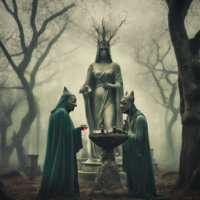
Thorsalon is a distinctive city originally established by Normarkians as the headquarters of the Blood Vineyards of the Far North. This company is renowned for producing wine uniquely flavored with human and animal blood, a practice steeped in ancient traditions and mystique. Situated along the rugged coastline of the Northern Strait of Haifa, Thorsalon is a hub of economic activity and cultural intrigue.
History
Thorsalon was founded by Normarkian settlers who sought to exploit the region's unique viticulture potential. The Blood Vineyards of the Far North quickly became the city's primary economic driver, drawing both fascination and revulsion from neighboring regions. Throughout its history, Thorsalon has maintained a degree of independence, with its unique product and strategic location providing both wealth and protection. The city has a storied past of defending its practices and traditions against external pressures, particularly during the Bassarid expansion in the early 49th Era.
Geography
Thorsalon is nestled between the Haemomantine Cliffs and the Erythraean Cave, creating a dramatic and otherworldly landscape. The Haemomantine Cliffs, composed of dark, iron-rich rock with veins of shimmering red minerals, rise majestically behind the city, providing both natural defense and an eerie beauty. The Erythraean Cave, named for its deep, reddish hue caused by mineral deposits and bioluminescent algae, extends beneath the cliffs and adds to the city's fantastical allure. The cave's subterranean river, known for its blood-red waters, is a source of mystery and legend, believed to enhance the mystical properties of the city's wines. Nearby lies the Mugwort Grove, a forest filled with ancient, twisted trees and abundant mugwort, regarded in local folklore as the Remembering Flower. This plant is highly valued for its use in inducing extremely vivid dreams and is a key ingredient in many of Thorsalon’s enchanted products. This enchanting geography makes Thorsalon a place of striking beauty and intrigue.
Economy
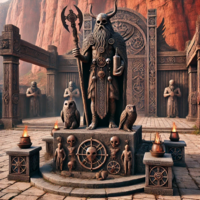
The economy of Thorsalon is heavily centered around the Blood Vineyards of the Far North, which produces the city’s renowned blood-infused wines. These wines, made from grapes grown in the mineral-rich soil of the Haemomantine Cliffs and infused with carefully sourced human and animal blood, are highly sought after for their unique flavor and supposed mystical properties. The vineyards employ a significant portion of the population, from grape pickers and vintners to blood alchemists and magical botanists. Additionally, Thorsalon has a thriving market for potions, crafted from the rare ingredients found in the Mugwort Grove and the Erythraean Cave. Mugwort, known across the Strait of Haifa as the Remembering Flower, is particularly prized for its ability to induce vivid dreams and is a key component in many of the city’s products.
Culture
Thorsalon's culture is deeply rooted in its Normarkian heritage and the unique practices of the Blood Vineyards. Cultural life in Thorsalon revolves around its vineyards, markets, and numerous festivals celebrating the city’s unique traditions. One of the most anticipated events is the Festival of the Crimson Harvest, held annually during the autumn equinox. During this festival, the city is adorned with blood-red banners and lanterns, and the streets come alive with music, dance, and theatrical performances depicting the city’s history. The highlight of the festival is the Blood Ritual, a ceremonial offering to the goddesses of the Haemomantine Cliffs, where participants present vials of blood to ensure a bountiful harvest and potent wine. The festival also includes a grand feast featuring delicacies such as blood sausage, red wine-braised meats, and enchanted pastries. The Festival of the Crimson Harvest is a celebration of Thorsalon’s unique heritage, blending tradition, mysticism, and community in a striking display of unity and pride.
Minor Cities in New South Jangsong
Pelagia
Pelagia is a unique city originally established by Bassarid military forces during the Strait of Haifa Campaign to secure and maintain critical supply lines. Following the campaign, the city was abandoned and later taken over by Normarkian camel herders, who transformed it into a vibrant center of trade and culture. Nestled along the shores of the Northern Strait of Haifa, Pelagia is a city of resilience and adaptation, blending its military origins with the pastoral traditions of its new inhabitants.
History
Pelagia was founded in the late 36th Era PSSC by Bassarid military forces as a strategic outpost to control supply lines during the Strait of Haifa Campaign. The city’s initial purpose was purely logistical, serving as a fortified hub for storing and distributing supplies to the Bassarid troops and their allies. However, following the conclusion of the campaign, the military abandoned Pelagia. Normarkian camel herders, seeking new grazing lands and trading opportunities, took over the deserted city. They adapted the infrastructure left behind by the Bassarids, incorporating their own pastoral and trading traditions, thus giving Pelagia a new lease on life.
Geography
Pelagia, located inland from the northern Strait of Haifa, is bordered by the Saltsteppes, a vast expanse where salt flats and hardy grasses create a stark, otherworldly beauty. Interspersed throughout the plains are oases, where sparse redwood trees and lush vegetation form verdant islands of life amidst the desolation. The Songs of Melusine, a local phenomenon where the wind sweeps across the salt flats creating haunting melodies, add a magical element to the region. These geographic features give Pelagia an otherworldly charm and strategic significance, making it a vital center for both trade and cultural exchange.
Economy
The economy of Pelagia is distinct and multifaceted, centered around trade, pastoralism, and unique local industries. The city serves as a bustling trading hub, with caravans arriving from distant lands to exchange goods such as spices, textiles, and artifacts. The Normarkian camel herders have adapted their traditional practices to the region, breeding camels known for their endurance and challenging climates of the northern Strait of Haifa. These camels are highly valued and form a significant part of the local economy. Additionally, Pelagia is renowned for its production of Salt Glass, a rare and beautiful type of glass produced from the salt which is mined in the Saltsteppes. This glass is sought after for its mesmerizing colors and is used in everything from jewelry to architectural elements. The city’s markets are vibrant and diverse, reflecting Pelagia's role as a central node in regional trade networks.
Culture
Pelagia's culture is a rich blend of Bassarid military heritage and Normarkian pastoral traditions. The city’s architecture features a mix of sturdy, functional military structures repurposed into homes and markets, alongside more recent constructions reflecting Normarkian aesthetics with flowing lines and open spaces. Cultural life in Pelagia revolves around its bustling markets, communal gatherings, and festivals celebrating the city’s unique history and traditions. One of the most anticipated events is the Festival of the Winds, held annually during the spring equinox. During this festival, the city is decorated with colorful banners and lanterns that dance in the wind. The festivities begin with a grand caravan parade, showcasing the finest camels and their ornate trappings. The highlight of the festival is the Wind Song Ceremony, where participants gather in the Saltsteppes to listen to the natural melodies created by the Winds of Melusine and sing along in harmony. The festival also includes music, storytelling, and feasts featuring local delicacies such as spiced camel meat and pastries. The Festival of the Winds is a celebration of Pelagia’s unique heritage, blending tradition and community in a display of unity and pride.
Myrene
Myrene is a renowned city founded by Haifan scholars who fled the Haifan peninsula following its annexation by the Bassarids in the aftermath of the Haifan Civil War. Established as a sanctuary for learning, philosophy, and the arts, Myrene has become a beacon of knowledge and culture, attracting intellectuals from across the region.
History
Myrene was founded in the early 39th Era by Haifan scholars seeking refuge from the Bassarid conquest of their homeland. These scholars established Myrene as a center of learning and philosophy, creating academies and libraries that quickly became focal points of intellectual activity. Over the centuries, Myrene has nurtured great minds and fostered debate, maintaining its status as a sanctuary for scholars even during times of regional turmoil. Despite occasional tensions with the Bassarids, Myrene has remained a bastion of independent thought and cultural preservation.
Geography
Myrene is uniquely situated in the Elysian Vale, a lush valley surrounded by the Parnassian Hills. The valley is nourished by the Nornstream River, whose waters are said to enhance clarity of thought and creativity. The Parnassian Hills, with their gleaming white marble and hidden caves filled with luminescent crystals, provide an impressive backdrop and a source of rare materials used in the city's architectural and artistic endeavors. This geography makes Myrene a place of both beauty and intellectual inspiration.
Economy
The economy of Myrene is centered around its academic institutions and the unique resources provided by its surroundings. The city's academies and libraries attract students, scholars, and visitors, contributing significantly to the local economy. Myrene is renowned for its production of Elysian Scrolls, made from the enchanted parchment of trees found in the Vale, and Norn Ink, derived from the waters of the Nornstream River. These scrolls and inks are highly prized for their durability and alleged mystical properties, used in everything from academic texts to enchanted manuscripts. The city also has a thriving artisanal sector, producing exquisite marble sculptures and jewelry crafted from the crystals of the Parnassian Hills.
Culture
Myrene's culture is deeply rooted in its Haifan intellectual heritage, with a strong emphasis on education, philosophy, and the arts. The city's architecture features classical elements, with stately academies, grand libraries, and elegant public spaces designed to inspire and educate. Cultural life in Myrene revolves around its academic calendar, with numerous lectures, debates, and symposia drawing participants from near and far. Festivals celebrating knowledge, the arts, and seasonal events are integral to the city's cultural fabric. One of the most anticipated events is the Festival of the Norn's Light, held annually during the summer solstice. During this festival, the entire city is illuminated with lanterns made from luminescent crystals, transforming Myrene into a glowing wonderland. The festivities begin with a grand procession through the city, featuring scholars and artists showcasing their works. The highlight of the festival is the Moonlit Symposium, an all-night gathering where participants discuss philosophical ideas and share their knowledge under the light of the full moon. The festival also includes music, storytelling, and feasts featuring local delicacies.
Thyrea
Thyrea is a storied city in the Normarkian region of New South Jangsong, established by Normarkian smugglers during the tumultuous Haifan Civil War. Over time, it transformed into a sanctuary for Bassarid worshipers of Agnis, the goddess of the underworld, who was expelled from the pantheon of the Reformed Stripping Path after her betrayal of Thalassa, the queen of the gods.
History
Thyrea was originally by Normarkian smugglers who capitalized on the chaos of the Haifan Civil War to establish a covert trading post. As the war subsided, the city attracted Bassarid exiles who worshiped Agnis, the goddess of the underworld, after she was cast out from the Reformed Stripping Path for her betrayal of Thalassa. These worshipers transformed Thyrea into a center of devotion and mysticism, blending their spiritual practices with the city’s smuggling roots. Over the centuries, Thyrea has grown into a thriving city known for its unique cultural and economic blend.
Geography

Thyrea is located on the shores of the enigmatic Lake Kedem, a mystical body of water believed to be connected to the underworld. The city is surrounded by the Shoshan Marsh, a marshland shrouded in perpetual mist. The Agnian River winds through the heart of the city. The nearby Orhaganaz Forest, home to ancient, sentient trees, adds to the city’s otherworldly atmosphere.
Economy
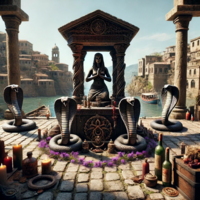
The economy of Thyrea is distinct and multifaceted, reflecting its origins and mystical influences. The city is a bustling hub for covert trade, with merchants dealing in rare and enchanted goods sourced from the Lake Kedem and the Orhaganaz Forest. Thyrea is renowned for its production of infused liquors, made from the herbs and of the surrounding wilderness. These liquors are highly sought after for their healing properties and psychoactive effects. Additionally, the city has a thriving artisan community, crafting intricate jewelry and artifacts imbued with the essence of the underworld, which are prized by collectors and spiritual practitioners alike.
Culture
Thyrea's culture is deeply rooted in its Normarkian smuggling heritage and the spiritual practices of the worshipers of Agnis. The city's architecture features dark, imposing structures adorned with symbols of the underworld and intricate carvings depicting the tales of Agnis and Thalassa. Cultural life in Thyrea revolves around its markets, spiritual gatherings, and numerous festivals celebrating the city’s unique heritage. One of the most anticipated events is the Festival of the Veil Unbound, held annually during the autumn equinox. This festival honors Agnis, the goddess of the underworld, and celebrates the thin boundary between the worlds of the living and the dead. During the Festival of the Veil Unbound, the city is adorned with deep purple and silver banners, and the streets are lit by lanterns made from bioluminescent plants, casting a mystical glow over Thyrea. The festivities begin with the Descent of Shadows, a solemn procession to the Temple of Agnis, where participants, dressed in cloaks representing the spirits of the underworld, carry offerings of fruits, flowers, and small effigies to honor the goddess. The central event of the festival is the Rite of Reflection, held at midnight by the shores of Lake Kedem. In this ritual, participants float candles on the lake's surface, creating a mesmerizing display of light reflecting off the water. The candles are said to carry messages and prayers to Agnis, seeking guidance and protection for the year to come. As the candles drift, the High Priestess of Agnis performs an incantation, believed to open a temporary passage between worlds, allowing the spirits to commune with the living. The festival also includes the Feast of Shadows, a grand banquet featuring dishes infused with herbs and ingredients from the Orhaganaz Forest and Shoshan Marsh. The night concludes with the Dance of the Veil, a dramatic performance where dancers, adorned in robes that shimmer like moonlight, move in intricate patterns that tell the story of Agnis' fall and her eternal watch over the boundaries of life and death. The Festival of the Veil Unbound is a profound celebration of Thyrea’s unique heritage, blending mysticism, reverence, and community in a captivating and unforgettable display.
Ephyra
Ephyra is a sacred city, revered as the home of the Oracle of the Normarkian Bassarid religion. Known for its spiritual significance and mystical landscape, Ephyra attracts pilgrims and seekers of wisdom from across the region. Nestled in a valley near the shores of the Strait of Haifa, the city is a beacon of divine insight and cultural richness.
History
Ephyra was established around the Temple of the Seer, where it is believed that the divine voice of the gods speaks through the oracle of Normarkian Bassaridianism, offering guidance and prophecies. Over time, the city has grown into a major spiritual center, with elaborate temples, shrines, and academies dedicated to the study of the divine and the mystical arts. Ephyra’s history is intertwined with the traditions of the Normarkian variant of the Bassarid religion, and it has long been a destination for those seeking enlightenment and communion with the gods.
Geography
Ephyra is situated in the Vale of Delpa, a lush valley surrounded by the Pythe Spine Mountains. The city is blessed with the sacred waters of the Vygsil Springs, a series of crystal-clear springs that flow through Ephyra, providing both life and mystical energy. The springs are said to have healing properties and are central to the city's spiritual practices. The surrounding landscape is dotted with ancient groves of the Et Khairn Forest, home to the largest single community of Morovian Sasquatch, and legendary flora, including the groves of Golden Oak, whose leaves are believed to grant visions of the future.
Economy
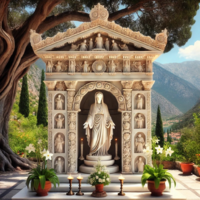
The economy of Ephyra is centered around its spiritual and mystical heritage. The city thrives on pilgrimage tourism, with thousands of visitors flocking to Ephyra each year to seek the Seer’s wisdom and partake in the sacred waters of the Vygsil Springs. Ephyra is renowned for its production of prophetic artifacts, such as the Oracle's Scrolls, inscribed with divinations and crafted from the bark of the Golden Oak. These scrolls are highly sought after for their spiritual significance and are used in rituals and ceremonies throughout the region. Additionally, the city has a vibrant market for enchanted items, healing tinctures and potions made from the sacred waters, and handcrafted talismans believed to bring protection and fortune. The artisanal sector in Ephyra is also known for its exquisite jewelry and ceremonial attire, often adorned with precious stones from the Pythe Mountains and magical herbs from the Et Khairn Forest.
Culture
Ephyra's culture is deeply rooted in its spiritual heritage and the traditions of the Normarkian Bassarid religion. The city's architecture features grand temples, serene shrines, and academies with intricate mosaics and carvings depicting the divine. Cultural life in Ephyra revolves around its religious calendar, with numerous festivals and ceremonies celebrating the divine and the mystical arts. One of the most anticipated events is the Festival of the Sacred Waters, held annually during the spring equinox. During this festival, the entire city is decorated with flowers and banners in shades of blue and gold, symbolizing the purity and divine energy of the Vygsil Springs. The festival begins with a grand procession to the Temple of the Seer, where participants carry offerings of fruits, flowers, and sacred herbs. The highlight of the festival is the Water Blessing Ceremony, where the Oracle herself blesses the springs, and attendees partake in the ritualistic bathing in the sacred waters, seeking healing and spiritual renewal. The festival also features the "Dance of the Divine," a mesmerizing performance by dancers clad in flowing garments that mimic the movement of water, accompanied by ethereal music played on lyres and flutes. The celebration includes storytelling sessions where elders recount the ancient myths and prophecies of the Seer, and feasts featuring dishes made with ingredients from the Et Khairn Forest and fresh fish from the Vygsil Springs. The Festival of the Sacred Waters is a profound celebration of Ephyra’s unique heritage, blending spirituality, tradition, and community in a captivating display of reverence and joy.
Halicarn
Halicarn is a majestic city built around the Grand Tomb of Dragevik, the greatest of all Normarkian heroes. Renowned for its historical significance and breathtaking landscape, Halicarn attracts visitors and devotees who come to honor the legacy of Dragevik and explore its rich cultural heritage. The city is a blend of myth, legend, and vibrant community life.
History
Halicarn was founded in commemoration of the Dragevik, the legendary hero known for his valor and wisdom. The Grand Tomb, a monumental structure crafted from Thalassian purple granite and adorned with intricate carvings, stands at the heart of the city. Over the centuries, Halicarn has grown into a thriving metropolis, with temples, academies, and markets that celebrate the hero's legacy. The city's history is steeped in the tales of Dragevik's adventures and the values he embodied, making it a place of pilgrimage and reverence.
Geography
Halicarn is situated in the verdant Valley of Heroes, surrounded by the Helicon Hills, whose peaks are dotted with ancient ruins and sacred sites. The city is traversed by the Orontes River, a sparkling waterway believed to possess healing properties. The river is fed by the crystal-clear springs of the nearby Asherah Grove, a mystical forest home to enchanted flora and fauna, including the mythical White Horned Bear, said to be a guardian of the land. The Valley of Heroes is known for its lush, fertile land and vibrant greenery, making it an oasis of beauty and tranquility.
Economy
The economy of Halicarn is centered around its historical and cultural heritage. The city thrives on tourism, with thousands of visitors coming each year to pay homage at the Grand Tomb of Dragevik and explore the surrounding sites. Halicarn is famous for its artisanal craftsmanship, particularly in the creation of Dragevik Relics, finely crafted replicas of the hero's weapons, armor, and other legendary artifacts. These relics are highly prized by collectors and historians. Additionally, the city produces healing tonics, tinctures and potions made from the waters of the Orontes River and the herbs of the Asherah Grove. Halicarn's markets are bustling with merchants selling enchanted items, historical texts, and exquisite jewelry adorned with gems from the Helicon Hills. The agricultural sector also plays a significant role, with the fertile valley yielding abundant crops and rare herbs.
Culture
Halicarn's culture is deeply rooted in the legacy of Dragevik and the traditions of heroism and honor. The city's architecture features grand monuments, elegant temples, and academies with detailed frescoes and statues depicting scenes from Dragevik's life. Cultural life in Halicarn revolves around its festivals and ceremonies, which celebrate the hero's deeds and the city's heritage. One of the most anticipated events is the Festival of Valor, held annually during the summer solstice. During the Festival of Valor, the entire city is adorned with banners and wreaths in gold and green, symbolizing courage and renewal. The festivities begin with a grand procession to the Grand Tomb, where participants, dressed as legendary heroes and heroines, offer tributes and recite epic tales of Dragevik's adventures. The highlight of the festival is the Trial of Heroes, a series of competitions that test the strength, skill, and wisdom of the participants, echoing the challenges faced by Dragevik. The festival also includes the "Dance of Triumph," a spectacular performance by dancers clad in shimmering costumes, accompanied by music from lyres, harps, and drums. The celebration features storytelling sessions where elders recount the epic sagas of Dragevik and other heroes, and feasts with dishes made from local ingredients, such as roasted game from the Asherah Grove and fruits from the fertile valley. The Festival of Valor is a profound celebration of Halicarn’s unique heritage, blending history, myth, and community in a captivating display of honor and pride.
Major Cities in Haifan Bassaridia
Keybir-Aviv
Keybir-Aviv is a historic city located near the eastern shore of Lake Morovia, within the northern Coral Woodlands. This Haifan Bassaridian city is famous for its deep economic and cultural connections to trade, as well as its rich spiritual traditions tied to the Stripping Path. With a significant legacy linked to the Wallis-Haifan Diamond Corporation, the city played a central role in the creation of the Protectorate of the Wallis Islands, the birthplace of the Kingdom of New Zimia and Passio-Corum.
History
Keybir-Aviv holds a unique place in Haifan and Bassarid history. The city was once the home of the Wallis-Haifan Diamond Corporation, a company central to the economy of the Free State of Haifa and instrumental in the creation of the Protectorate of the Wallis Islands. These islands later became the birthplace of the Passio-Corum, which itself would later evolve to become become the Haifo-Pallisican Imperial Trade Union. The corporation’s activities in diamond mining brought immense wealth and influence to Keybir-Aviv, fostering its growth as a key trade hub. Over time, as the city came under Bassarid control, it maintained its importance as both a center for commerce and spiritual activity, with its practitioners preserving many of the original traditions of the Stripping Path.
Geography
Keybir-Aviv is located near the eastern shore of Lake Morovia, within the northern Coral Woodlands, near the western edge of the Valley of Abeis. The Coral Woodlands are a unique forest characterized by ancient, millennia-old giant coral formations, which give the region its distinct landscape. The city's proximity to Lake Morovia ensures it remains a critical node in connecting northern and southern Lake Morovia, while also linking the Haifan Plateau and Peninsula to the wider region, including the Strait of Haifa.
Economy
The economy of Keybir-Aviv has long been driven by its strategic position along Lake Morovia, serving as a critical link between the northern and southern shores of the lake. Historically, the city benefited immensely from the diamond industry, particularly through the Wallis-Haifan Diamond Corporation, which established the city as a powerful economic force. In modern times, trade continues to be the lifeblood of Keybir-Aviv’s economy, with its port facilitating commerce between the Haifan Plateau, the Strait of Haifa, and other important Bassarid and Haifan regions.
Culture
Culturally, Keybir-Aviv is a stronghold of traditional Stripping Path philosophy. In contrast to much of Bassaridia Vaeringheim, where the Reformed Stripping Path has taken root, Keybir-Aviv remains a bastion for practitioners of the original Stripping Path. Local cults largely reject the more modern interpretations of the faith, instead adhering to the older practices that have existed for centuries. The city’s spiritual life revolves around the worship of Hermes, considered the patron deity of Keybir-Aviv, as well as the veneration of lesser deities like the Western Wind. The city is known for its vibrant festivals and public rituals, all deeply rooted in its enduring connection to the ancient Stripping Path traditions.
Tel-Amin
Tel-Amin is a historic city located near the western shore of the Southern Strait of Haifa, within the dense and ancient Coral Woodlands. It is the southernmost of the original Haifan cities and holds great significance both economically and culturally in the region. Famous for its spiritual practices tied to the traditional Stripping Path, Tel-Amin also played a key role during the Haifan Civil War, becoming a contested battleground.
History
During the Haifan Civil War, Tel-Amin became one of the main focal points of the conflict. Situated in a strategically crucial position along the Strait of Haifa, the city was fiercely contested by the New Zimian War League and the Jezeri forces. It was eventually captured by the Bassarid forces after a series of air raids and naval blockades, marking a significant victory in the war. The battle for Tel-Amin was especially intense due to its proximity to important overland trade routes and access to maritime markets. After the war, Tel-Amin remained under Bassarid control, helping to solidify their dominance in southern Haifan Bassaridia.
Geography
Tel-Amin is located along the eastern shore of the Southern Strait of Haifa in the region known as the Plains of Melusine. The region is part of the Coral Woodlands, which are famous for their ancient and dense coral formations. Unique to the area are the skeletons of massive mermaid-like beings that protrude from the ground. The city’s position on the strait has historically made it an important point along trade routes, facilitating connections between the Haifan Peninsula and the Maritime Markets.
Economy
Tel-Amin’s economy has long been supported by its location along key overland trade routes that connect the Haifan Peninsula to the Maritime Markets of the Strait of Haifa, particularly the city of Mylecia, which remains under the control of the Imperial Federation. The city’s strategic location has also made it a haven for pirates and smugglers throughout history, including the legendary Captain Ismael Hatch. Its proximity to maritime and overland trade networks continues to support its economy, even after the war.
Culture
Culturally, Tel-Amin is defined by its practice of the traditional Stripping Path, in contrast to the Reformed Stripping Path practiced in northern Haifan regions. The city’s patron deity is Apollo, and its form of worship pays homage to this divine figure. Additionally, Tel-Amin is home to a unique cult that exclusively worships the Host Spirit, which is distinct from other sects or mysteries within the Stripping Path. This spiritual independence, combined with its deep-rooted traditional practices, makes Tel-Amin a key center for religious life in southern Haifa.
Diamandis
Diamandis is a major city located south of Tel-Amin, near the famed Valley of Diamonds. It serves as a key economic and cultural hub in southern Haifan Bassaridia, particularly for the region's lucrative diamond trade. The city is home to the Merchants of the Valley of Diamonds, a prominent company based in the General Port of Lake Morovia, further highlighting its importance in both regional and international commerce.
History
Diamandis’s historical importance stems from its proximity to the Valley of Diamonds, which has long been a source of immense wealth due to its abundant diamond deposits. The city grew into a center of commerce, particularly in the diamond trade, attracting merchants from across the region and beyond. Throughout its history, Diamandis has played a key role in trade networks that span the Haifan Peninsula and the greater Bassaridian economy, with its strategic location making it a focal point for economic activity.
Geography
Diamandis is situated near the Valley of Diamonds, surrounded by fertile plains that provide important overland trade routes. Its location is pivotal, connecting it to the broader economic landscape of Haifan Bassaridia, especially trade networks that span the Haifan Peninsula, the southern plains, and the Strait of Haifa. The region is rich in natural resources, most notably diamonds, making it an essential economic engine for the area.
Economy
The economy of Diamandis is driven by its proximity to the diamond mines of the Valley of Diamonds. The Merchants of the Valley of Diamonds, a company headquartered in the General Port of Lake Morovia, operates extensively in Diamandis, ensuring that diamonds from the valley reach both regional and international markets. In addition to diamond trade, the city benefits from overland trade routes that link it with neighboring regions and major hubs like Mylecia, enhancing its status as an economic powerhouse in southern Haifa.
Culture
Culturally, Diamandis shares much with its neighboring Haifan cities, particularly in its devotion to the traditional Stripping Path. Aphrodite is the city's patron deity, and the people of Diamandis incorporate diamond-related symbolism into their religious and spiritual practices, honoring the wealth and prosperity brought by the valley. Unique rituals and festivals in Diamandis often center around the diamonds themselves, integrating the city’s economic lifeblood into its spiritual identity. This deep-rooted connection between commerce and faith sets Diamandis apart, blending prosperity with reverence for the divine.
Jogi
Jogi is a city located on the eastern shore of the Southern Strait of Haifa and is unique among the Bassaridian cities for having originally been established as part of the Maritime Markets of the Strait of Haifa. The city has historically been regarded as the "breadbasket" of the Southern Strait, playing a vital role in the region's agriculture and trade. Its strategic location, combined with its agricultural output, has allowed Jogi to thrive as a key player in the Bassaridian economy.
History
Founded by the Independent Realm of Ergonia in 30.94 PSSC, Jogi was established as part of a larger effort to develop the original Trans-Keltian Railway. Initially, it became a haven for pirates and tradesmen, many of whom took advantage of the region’s relative lawlessness following the collapse of Ergonia. Jogi later aligned with the Bassarids, solidifying its place as a hub within the Maritime Markets of the Strait of Haifa, a network of pirate-run trade hubs. The city continued to flourish under Bassarid control, but pirate activity remained an ongoing issue due to the region's historic ties to piracy and smuggling.
Geography

Jogi is situated on the eastern shore of the Southern Strait of Haifa, in the region known as the Plains of Jogi. The area is characterized by fertile valleys and plains, making it ideal for agriculture. The climate of the region is temperate, which supports the cultivation of various crops that have earned Jogi its reputation as the breadbasket of the Southern Strait.
Economy
Jogi’s economy has long been based on agriculture, with several important agricultural producers and exporters operating out of the city. The fertile plains of the surrounding area support the cultivation of wheat, oats, and other staple crops. Additionally, the city is home to the Ale of the Night Central Brewery, known for its hallucinogenic beer that has become popular among the region’s pirates. Jogi's agricultural exports, combined with its position along key overland and maritime trade routes, make it a critical part of the Bassaridian economic system.
Culture
Culturally, Jogi is aligned with the traditional Stripping Path, similar to other cities in the Southern Strait. The city’s religious practices are distinct from the Reformed Stripping Path found in the northern regions of Bassaridia. Instead, the people of Jogi maintain traditional worship practices, paying homage to deities such as Apollo, who is revered as the city's patron deity. In addition to its religious significance, Jogi remains culturally tied to its origins within the Maritime Markets, with a continued connection to piracy and smuggling that has shaped its local identity.
Lewisburg
Lewisburg, located in the swampy and heavily forested western interior of Haifan Bassaridia, was originally established as a vital hub connecting the Hammish region of Haifa to the Kingdom of Hamland’s core territories in western Keltia. Over centuries, its strategic location cemented its role as a trade, cultural, and political center. Today, it thrives as a major depot along the Trans-Bassaridia Railway, facilitating trade and transportation across Bassaridia Vaeringheim. However, Lewisburg's culture and identity remain profoundly shaped by the dark legacy of the Order of Rochefort and the Southern Lake Morovia Campaign, which ended the order's influence and ushered in a new era for the city.
History
Founded by the Kingdom of Hamland, Lewisburg initially served as a logistical and administrative hub linking the Hammish territories of Haifa with the greater kingdom. It played a key role in facilitating the movement of goods and people, becoming a cornerstone of regional trade networks. Under the Kingdom of Caputia, Lewisburg rose to prominence but also became the epicenter of one of the darkest chapters in the region’s history. The city served as the headquarters of the Order of Rochefort, an anti-Bassarid extremist organization responsible for orchestrating the genocide of practitioners of the Stripping Path during the 36th Era PSSC. This period left deep scars on Lewisburg’s social and cultural fabric, as the Order’s influence entrenched division and persecution. The Southern Lake Morovia Campaign during the 50.40s PSSC marked a turning point in Lewisburg’s history. This brutal and complex military campaign by Bassaridia Vaeringheim sought to dismantle the remaining vestiges of the Order of Rochefort. The campaign combined military force with cultural reintegration efforts, ultimately eliminating the Order’s presence and annexing Lewisburg into Bassaridia Vaeringheim. While this transformation allowed the city to rebuild and thrive, the echoes of its turbulent past still resonate in its cultural identity.
Geography
Lewisburg is located in the swampy lowlands and dense forests of western Haifan Bassaridia, characterized by elevated infrastructure to mitigate seasonal flooding. The surrounding wetlands and forests provide timber, medicinal plants, and a rich ecosystem supporting the local economy. Its strategic position near the western shore of Lake Morovia makes it a critical hub along the Trans-Bassaridia Railway, which connects southern Haifan Bassaridia to northern New South Jangsong. The city’s location ensures its role as a vital link between regions, reinforcing its economic and logistical significance.
Economy
The city's economy is anchored by its position as a major depot along the Trans-Bassaridia Railway. Serving as a conduit for goods moving between Haifan Bassaridia, Bassaridia Vaeringheim Proper, and New South Jangsong, Lewisburg facilitates the exchange of agricultural products, artisanal crafts, and advanced technologies. Its bustling markets and industrial zones reflect its role as a key player in the Bassaridian trade network.
Natural resources from the surrounding wetlands, including timber and herbal medicines, further diversify the economy, while the railway supports continuous urban growth. The integration of Lewisburg into the larger Bassaridian economy after the Southern Lake Morovia Campaign allowed the city to overcome its historical stagnation and embrace modernization.
Culture
The culture of Lewisburg remains significantly impacted by its dark past as the center of the Order of Rochefort and the trauma of the Southern Lake Morovia Campaign. While the city has embraced Bassaridian unity and the Reformed Stripping Path, the legacy of persecution and violence has left lasting imprints. Annual commemorations and festivals honor the resilience of the Stripping Path’s practitioners and the victory over the Order, blending sorrowful remembrance with celebrations of renewal and unity. Monuments and shrines to the Reformed Stripping Path stand alongside preserved ruins of the Order’s former strongholds, serving as stark reminders of the city’s transformation. Many of the city’s cultural traditions reflect themes of resilience and reconciliation, with art, music, and storytelling often addressing the struggle against oppression and the hope for a harmonious future. The city’s cuisine and crafts showcase its diverse influences, incorporating flavors and styles from its Hammish, Caputian, and Bassaridian heritage. However, the dark legacy of its past adds a layer of introspection to its cultural identity, as Lewisburg continues to reconcile its history with its role as a thriving modern hub in Bassaridia Vaeringheim. Lewisburg stands as a symbol of both the atrocities of the past and the potential for renewal and growth, a city forever shaped by its history yet looking toward a unified future.
Minor Cities in Haifan Bassaridia
Thermosalem
Thermosalem is a serene city renowned for its natural hot springs, a place where wellness and tranquility are deeply embedded in its identity. The city's springs have drawn visitors for centuries, making it a destination for healing and rejuvenation. Surrounded by rolling hills and forests, Thermosalem offers a perfect retreat from the stresses of life, with its economy and culture centered on the benefits of nature and wellness.
History
The history of Thermosalem dates back centuries, originating as a small settlement centered around the city's famed hot springs. These springs were believed to have healing properties, and the site became a pilgrimage destination for those seeking natural remedies. Over time, the city grew as health-focused travelers and settlers came to build around the springs. While other regions were often caught in political upheavals or warfare, Thermosalem remained a peaceful haven, its growth fueled by a dedication to wellness and a reputation as a place of rejuvenation.
Geography
Thermosalem is nestled in a picturesque valley surrounded by gently rolling hills and verdant forests. The city’s landscape is defined by natural hot springs, which bubble up from beneath the earth, creating a network of thermal baths throughout the area. Lush vegetation thrives in the humid climate created by the springs, and the city is crisscrossed by small streams that flow into nearby rivers. The surrounding hills act as a natural barrier, making the city feel secluded and tranquil, with hiking trails and pathways weaving through the scenic countryside.
Economy

The city’s economy revolves around its natural springs, with wellness tourism forming the backbone of its financial structure. Thermosalem's thermal baths and health retreats draw visitors from near and far, providing services such as spa treatments, meditation, and eco-friendly lodging. Local artisans sell products inspired by the springs, such as natural skincare products, herbal remedies, and handmade crafts. Farming and small-scale agriculture also play a role in supporting the city's needs, with local produce and herbal ingredients contributing to the wellness-focused culture.
Culture
Thermosalem's culture is heavily influenced by its connection to nature and healing. The city hosts an annual "Festival of Renewal," where locals and visitors alike celebrate the healing powers of the springs through communal rituals, music, and dance. The city’s residents place a strong emphasis on physical and spiritual well-being, and many are involved in professions related to health, natural medicine, and wellness. Daily life is slow-paced and mindful, with community events often centered around meditation, herbal medicine workshops, and nature conservation efforts.
Akróstadium
Akróstadium is a small, fortified city originally established as a monastery for initiate officers and commanders of the War League. Built on a strategic hill, the city reflects a deeply martial heritage, with its architecture and traditions emphasizing discipline, strength, and training. Today, the economy is driven by pastoralism, with local ranchers raising Morovian Water Buffalo, South Haifan Camels, and sheep.
History
Founded as a monastery for the training of War League officers, Akróstadium was designed as a place of discipline and military instruction. The city’s role evolved over time, but its martial roots remain central to its identity. The once-monastic center became a hub for strategic military contests and exercises, drawing in recruits and commanders from across the region to train and sharpen their skills.
Geography
Akróstadium is situated atop a prominent hill, overlooking vast plains and rugged landscapes. Its elevated position gives the city a natural defensive advantage and provides stunning views of the surrounding terrain. The hill’s slope is terraced, with fortified walls and rows of buildings leading up to the city’s grand stadium, the heart of its traditional military activities.
Economy

Today, Akróstadium’s economy revolves around pastoralism. The city is home to many ranchers who raise Morovian Water Buffalo, South Haifan Camels, and sheep. These livestock are vital for local commerce, with wool, milk, meat, and hides being traded. Though its military past is ever-present, the city’s shift to pastoralism represents a harmonious blend of tradition and modern livelihoods.
Culture
Culturally, Akróstadium is heavily influenced by the Reformed Stripping Path. The city’s major temple is operated by the Azure Sentinel Sect, a powerful cult devoted to the Empress Goddess Thalassa. The temple is a center for spiritual guidance, worship, and festivals. However, many resident of the city, whose patron deity is Aphrodite, still adhere to the traditional Stripping Path, a practice intertwined with the city’s martial roots. Honor, discipline, and reverence for tradition define the city's cultural identity, with public celebrations often focused on both the divine and the city’s military past.
Sufriya
Sufriya is a bustling cultural hub located on the western shore of the Strait of Haifa, strategically positioned south of the former Haifan capital Abeis and near the boundary with the Imperial Federation. The city’s rich history, shaped by its role during the Haifan Civil War and its diverse cultural influences, makes it an essential trade and cultural center within Bassaridia Vaeringheim.
History
Founded during the height of the Haifan Civil War, Sufriya emerged as a vital base for merchants, spies, and pirates operating around the eastern Abeisan Inlet and archipelago. These groups used the city to transport goods, gather intelligence, and plunder ships and sea-ports. Its strategic location along the Strait of Haifa provided easy access for those seeking to control regional trade routes. In the war's aftermath, the city began to formalize its operations and develop into a center of legitimate commerce and cultural exchange, while still retaining the clandestine undertones from its early days.
Geography
Sufriya is situated along the southern coast of the Strait of Haifa, just south of Abeis, the former capital of Haifa, and near the border between Haifan Bassaridia and the Imperial Federation. It occupies a critical point along the eastern boundary of the Abeisan Inlet, giving it direct access to maritime trade routes that connect Lake Morovia with the Southern Strait. The city’s geography, with its coastal location and proximity to both Haifan and Imperial territories, continues to make it a pivotal hub for sea-based trade.
Economy
The city’s economy thrives on its role as a major trade hub, particularly for companies operating out of the General Port of Lake Morovia. Key businesses such as the Plains of Jogi, Ale of the Night Central Brewery, and the Thalassian Granite Export Cooperative use Sufriya as an important transit point for goods passing between the Southern Strait and Lake Morovia. Its ports bustle with ships carrying textiles, foodstuffs, ale, granite, and more, as Sufriya’s merchants manage the flow of goods vital to the Bassarid economy.
Culture
Sufriya represents a rich fusion of Haifan and Bassaridian cultures, making it one of the most culturally diverse cities in the region. The city's Jezeri population adds another layer of complexity to Sufriya's identity, contributing to its unique blend of religious and artistic practices. Residents practice a wide range of spiritual traditions, including the Stripping Path, the Reformed Stripping Path, and belief systems from New South Jangsong. The influence of trade and interaction with visitors from across the Southern Strait, Lake Morovia, and beyond further enriches the city’s cultural landscape. Sufriya’s festivals often reflect this diversity, featuring vibrant celebrations of both maritime and spiritual significance, blending the city’s artistic, religious, and economic life into a harmonious whole.
Lykopolis
Lykopolis is a city of great spiritual and industrial significance, located northwest of Mylecia in the heavily forested and coal-rich region of the Valley of Haifa. The city is defined by its continuing devotion to the Priestess of Agripinilla and its role as the home of the Mylecian Coal Ports.
Geography
Lykopolis is set in a rugged, forested landscape dotted by ancient and contemporary coal mines. Many of these abandoned mines have been converted into shrines and temples dedicated to the Priestess of Agripinilla, Dionysus, and various regional deities. These sacred spaces host mysterious rites practiced by some of the most ancient Bassarid cults, preserving traditions that have persisted for centuries. The dense forests and scarred earth give Lykopolis a unique character, where industrial activity coexists with deep spiritual reverence.
History
Lykopolis has a profound connection to the Stripping Path, with a longstanding reverence for the Priestess of Agripinilla, once regarded as the High Priestess of the Stripping Path and oracle of the Host Spirit. The city’s religious traditions have always been closely tied to its industrial development, with spiritual authority guiding much of its growth. Although the Priestess’s influence has waned across most of Bassaridia, Lykopolis remains one of the last bastions of her power, where her spiritual guidance continues to shape the city’s identity.
Economy
The city is economically driven by its coal industry, with the Mylecian Coal Ports playing a central role. Established in 33.66 PSSC as part of the Port of Mylecia, the Mylecian Coal Ports are one of the oldest companies featured on the General Port of Lake Morovia. Coal from Lykopolis fuels industries across Bassaridia Vaeringheim, and the city's connection to the broader trade network via Lake Morovia and the Strait of Haifa makes it a key player in regional commerce. Mining and export dominate the city's economy, providing vital resources and employment for the population.
Culture
Though not the official head of government, the Priestess of Agripinilla wields immense influence over the city’s governance, shaping its social and political fabric. Lykopolis remains deeply devoted to to the Priestess and to the city's patron deity, Bacchus, with many festivals and public rituals focused on Dionysian rites. The former coal mines, now functioning as sacred shrines, are central to the city’s cultural and religious life. These sites host ancient Bassarid cults that practice their rites in secret, maintaining a connection to Lykopolis’ historical roots. This blend of industrial strength and spiritual devotion defines the unique cultural identity of the city, where economic activity and religious reverence are intertwined.





